Sun news August 31: Geomagnetic storms keep coming!
Our active sun continues to disturb Earth’s geomagnetic field. At the time of this writing a G1 (minor) geomagnetic storm is ongoing. The threshold was reached at 9:15 UTC. We saw activity the whole time during our observation period between 11 UTC yesterday and 11 UTC today. Late yesterday and early today we saw another G1 disturbance, during the 0-3 UTC period. People have reported auroral displays in Europe, Canada and the U.S. The G1 storming occurred during the dark hours in the U.S. and Canada. Did you see ’em? Turning back to the sun, we saw an increase in solar activity on the Earth-facing side of our sun with moderate levels. We had three M flares and 12 Cs, and it seems the far side of our star is quite active. Gorgeous prominences on the northeast and northwest limb (edge) tell the story. Those prominences were produced on the far side. Filaments and active regions on the northeast should show up on the Earth-facing solar disk in the next days.
Last 24 hours: Sun activity continues at moderate levels in the past day, with four M flares. We noticed an increase in flaring activity. During our observation period between 11 UTC yesterday and 11 UTC today, the sun sparked 16 flares compared to five flares the previous days. In total, there were four Ms plus 12 Cs. Active region AR3806 blasted out the largest flare of the day, an M3.8 at 12:20 UTC on August 30. It provoked an R1 (minor) radio blackout over Ghana in Africa. This sunspot region – AR3806 – is now in the southeast quadrant and continues its growth, keeping its magnetic configuration. It bears the most complex beta-gamma-delta configuration, meaning potential for more M flares and even X flares. Lead flare producer of the period was active region AR3807, which sparked seven flares. This is the list of M flares of the period:
• M3.8 at 12:20 UTC on August 30 from AR3806. R1 (minor) radio blackout over Ghana in Africa.
• M1.1 at 0:49 UTC on August 31 from AR3806. R1 (minor) radio blackout over the Pacific Ocean.
• M1.2 at 2:38 UTC on August 31 from AR3806. R1 (minor) radio blackout over the Philippine Sea.
• M1.2 at 8:59 UTC on August 31 from incoming unnumbered yet active region. R1 (minor) radio blackout over Ethiopia in Africa.
Today the sun shows nine numbered active regions. One of them is a newcomer in the southeast quadrant with the label AR3808. Out of the nine active regions, we have a beta-gamma-delta (AR3806), a beta-gamma (AR3807) and the rest of the visible sunspot groups have simple alpha or beta configurations and look stable or in decay.
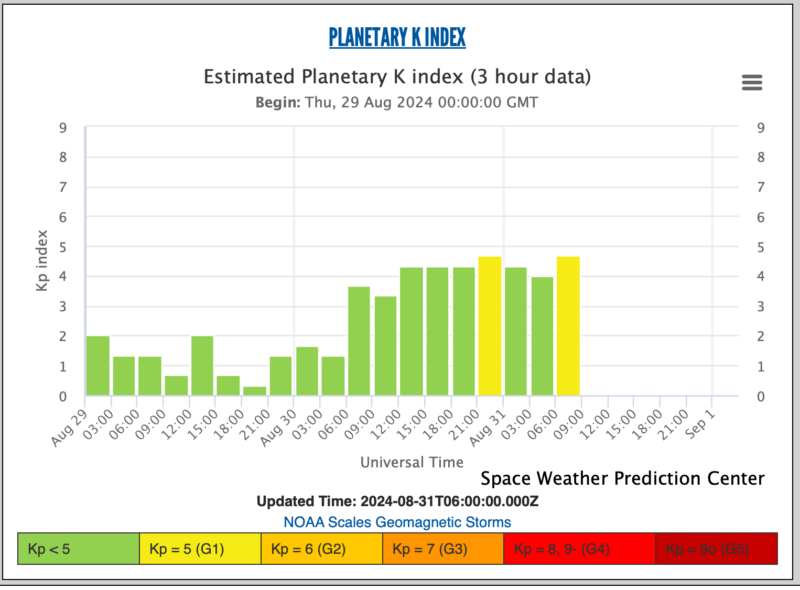
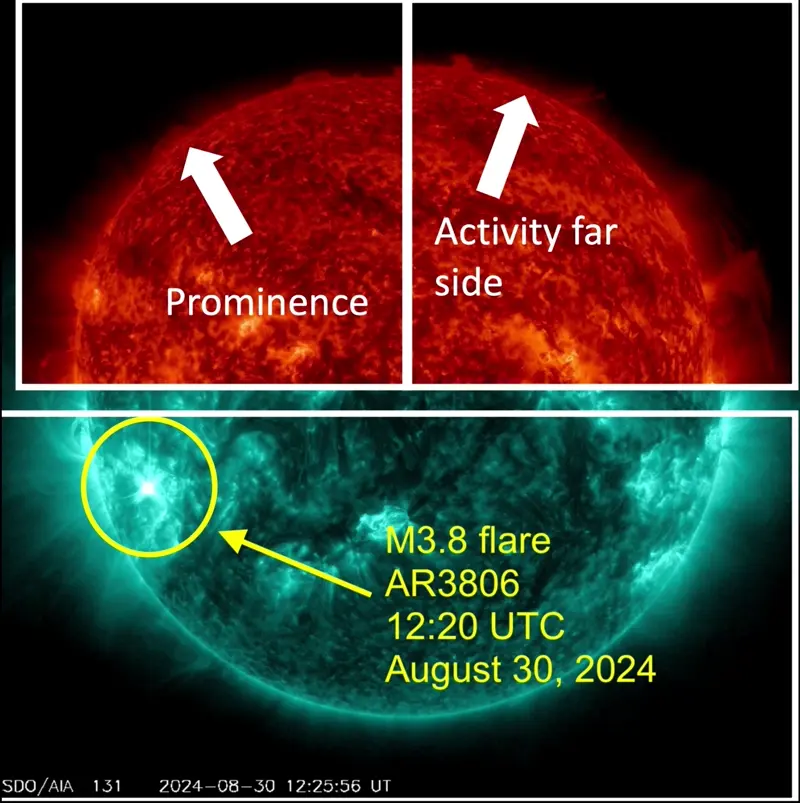
Sun news August 30: Geomagnetic disturbance continues!
The unexpectedly strong geomagnetic activity of the past few days is continuing, following Earth’s glancing blow from a blob of sun-stuff on Wednesday. A Kp = 4 disturbance is ongoing at the time of this writing (11 UTC, August 30). These conditions may have brought auroral displays to northern locations such as Tromsø in Norway and Alaska in the US. And luckily, it was dark in northern areas of the US at the time of the disturbance. Did you see any auroras? Show us your photos! And don’t forget to join us in our live stream today at 12:15 p.m. EDT (17:15 UTC), where we’ll be discussing some exciting solar news. Don’t miss it!
Last 24 hours: Sun activity is back to moderate thanks to an isolated M flare from sunspot region AR3806 in the southeast quadrant. The blast occurred at 2:06 UTC on August 30 and caused an R1 (minor) radio blackout that affected an area where the Pacific Ocean and the Philippine Sea meet. This sunspot region, AR3806, just rotated into view yesterday. And now that we can see it fully for a better analysis, specialists found a delta region in its magnetic configuration; it bears the most complex beta-gamma-delta configuration, meaning it has the potential for more M flares and even X flares. Between 11 UTC yesterday and 11 UTC today, our observation period, the sun produced a total of 12 flares: the aforementioned M and 11 Cs. The lead flare producer of the period was active region AR3806, which sparked five flares: four C flares and the M. The sun currently bears eight labeled sunspot regions on its Earth-facing side. There is a newcomer in the southeast quadrant now numbered AR3807, which is showing a beta-gamma configuration. The rest of the visible sunspot groups have simple alpha or beta configurations and look stable or in decay.

Sun news August 29: More geomagnetic storming!
The blob of sun-stuff that gave Earth a glancing blow yesterday has continued to surprise us. After producing a stronger-than-expected geomagnetic storm in the early hours of yesterday morning, it produced an unanticipated second wave of disturbance this morning, with another G2 (moderate) geomagnetic storm recorded. The Kp = 6 threshold was reached at 0:03 UTC, before reducing to Kp = 5 at 6 UTC. Did you see the auroras? Show us your photos! Meanwhile, more action could be brewing on the sun. Although only C flares were produced over the past day, we saw a couple of exploding filaments hurling coronal mass ejections (CMEs) into space, one on the northwest quadrant and another in the vicinity of AR3799. These small CMEs, combined with fast solar wind from the current coronal holes, could lead to a similar glancing blow to the one that just disturbed Earth’s magnetic field twice. Stay tuned!
Last 24 hours: Only C flares were produced in the past day, keeping solar activity at low levels. However, we are seeing some very exciting, energetic prominence activity. A prominence on the eastern limb erupted, uncurling as it left the sun and producing a beautiful CME. Two dynamic but currently stable prominences on the west-northwest limb (edge) have been dancing high in the solar atmosphere. And there is a long transequatorial filament crossing from the northeast quadrant through the northwest to the southwest. We have seen long filaments like this one exploding into gorgeous plasma prominences, so we’ll keep observing this one! Between 11 UTC yesterday and 11 UTC today, the sun produced a total of nine C flares, a slight increase from the five fired yesterday. Two C7.0 flares were the joint-largest, the first produced at 20:38 UTC on August 28 by AR3801 and the second at 4:18 UTC on August 29 by AR3806. AR3806 was the leading flare producer of the period with six flares. Currently, the sun has nine active regions on its Earth-facing side. There is a newcomer on the east limb (edge) now numbered AR3806. Three regions show a beta-gamma magnetic configuration: AR3796, AR3799 and AR3800. The rest show alpha or beta configurations, and are stable or in decay with low flare productivity.
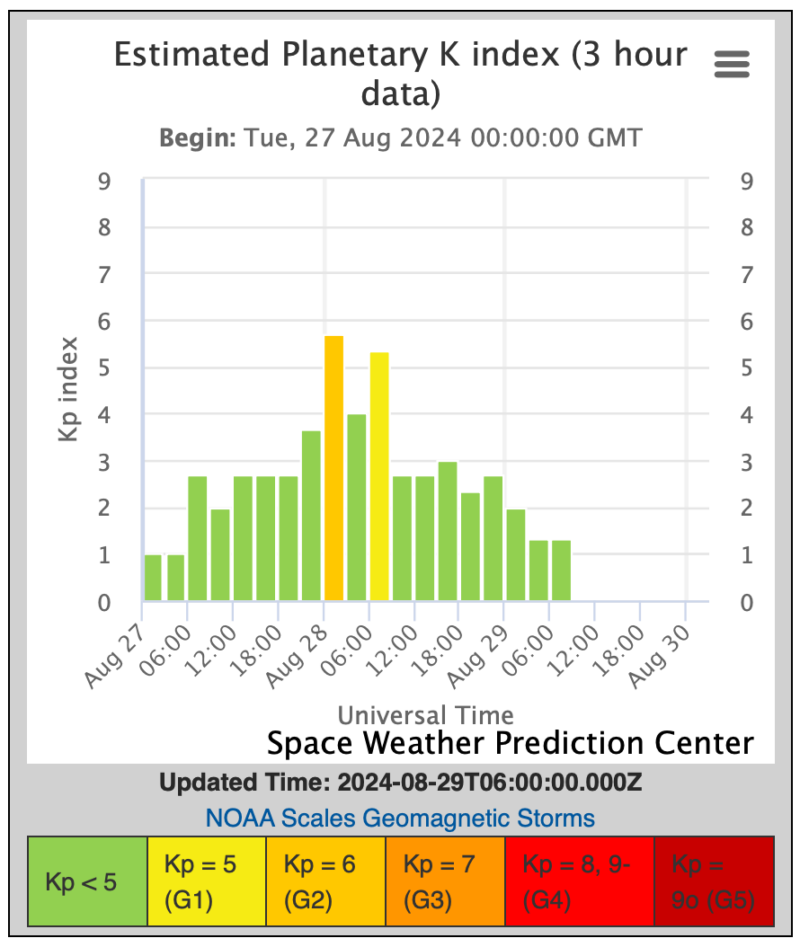
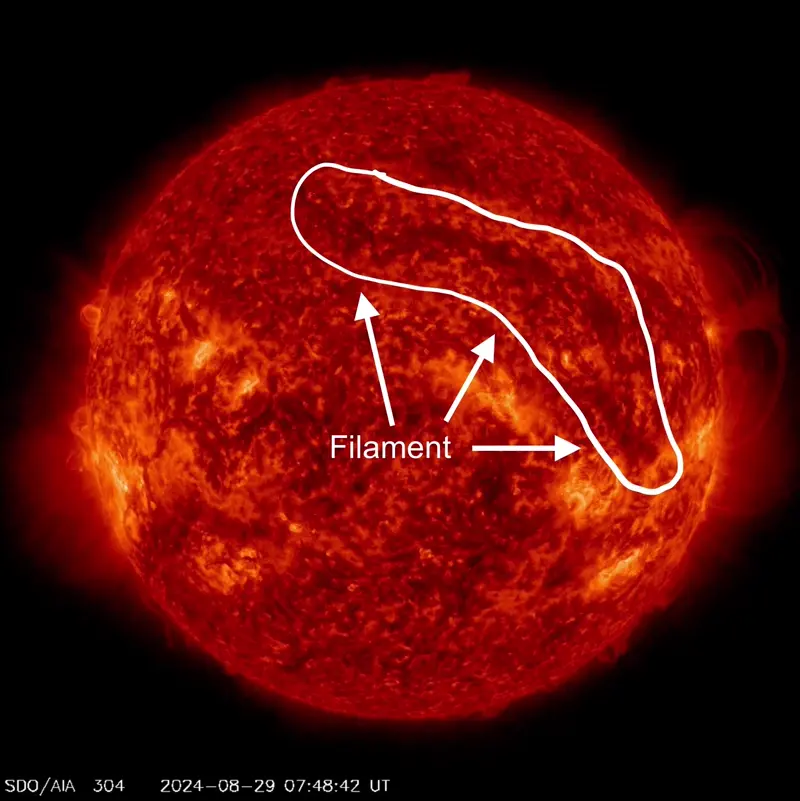
Sun news August 28: Auroras! More to come?
A stronger-than-expected geomagnetic storm began today (UTC) shortly after a weak shock wave due to the August 23 coronal mass ejection (CME) delivered a glancing blow at Earth. A G1 storm started around 2:12 UTC, then a G2 around 3 UTC, calming to a G1 around 7 UTC. We are now back to active levels. These geomagnetic conditions provided an opportunity to observe auroras to lower latitudes, such as the northern boundaries of US states like Oregon and Wyoming in the US and down to Dombås in Norway. Did you see the auroras? Captured a photo? Share! Could this geomagnetic activity continue? We have a chance for more G1 storming. Alert for Aurora Chasers. Stay tuned.
Last 24 hours: Solar activity dropped to low levels during the past day with only C flares. During our observation period from 11 UTC yesterday to 11 UTC the sun produced five C flares. The largest event was a C5.1 flare at 15:45 UTC on August 27 from sunspot region AR3800. The sun has eight active regions. Four regions retained a beta-gamma magnetic configurations: AR3790, AR3796, AR3799 and AR3800 and the rest show an alpha or beta configuration. All remain stable with low flare productivity. This lull in activity may seem very strange given that the sun is currently in the part of its activity cycle called solar maximum. This is a normal part of the 11-year cycle solar cycle. Solar maximum doesn’t mean the sun is in a continuous state of high activity but that it experiences days or weeks of high activity with small lulls in between, and the periods of activity are stronger. Activity is more than just flaring. We are seeing some very exciting, energetic prominence activity. A prominence on the eastern limb erupted, uncurling as it left the sun. This produced a beautiful CME visible in the SOHO LASCO C2 and C3 coronagraphs. Two dynamic but currently stable prominences on the west-northwest limb (edge) are dancing high in the solar atmosphere.
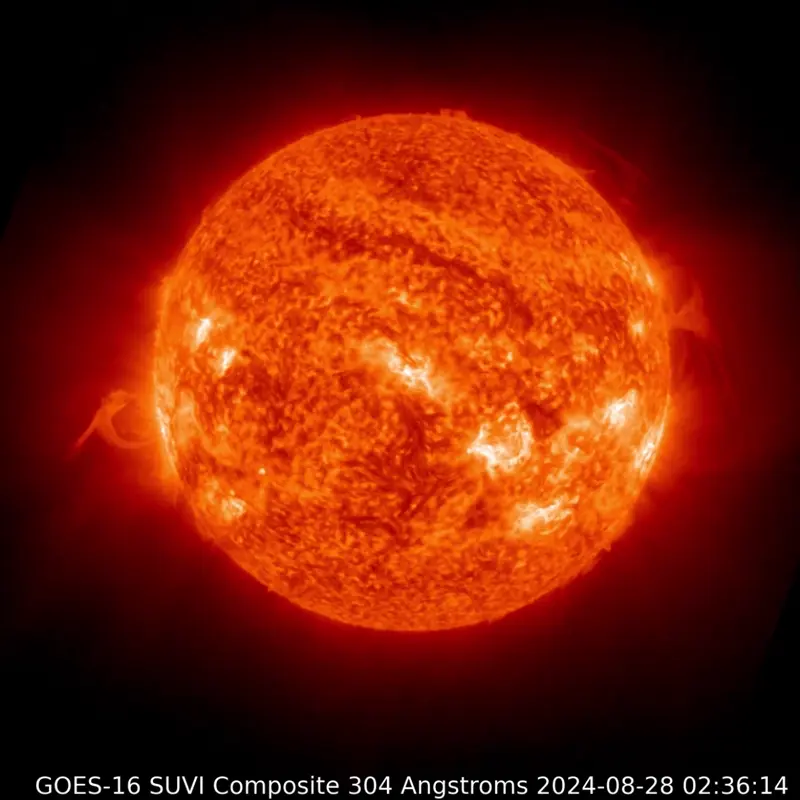
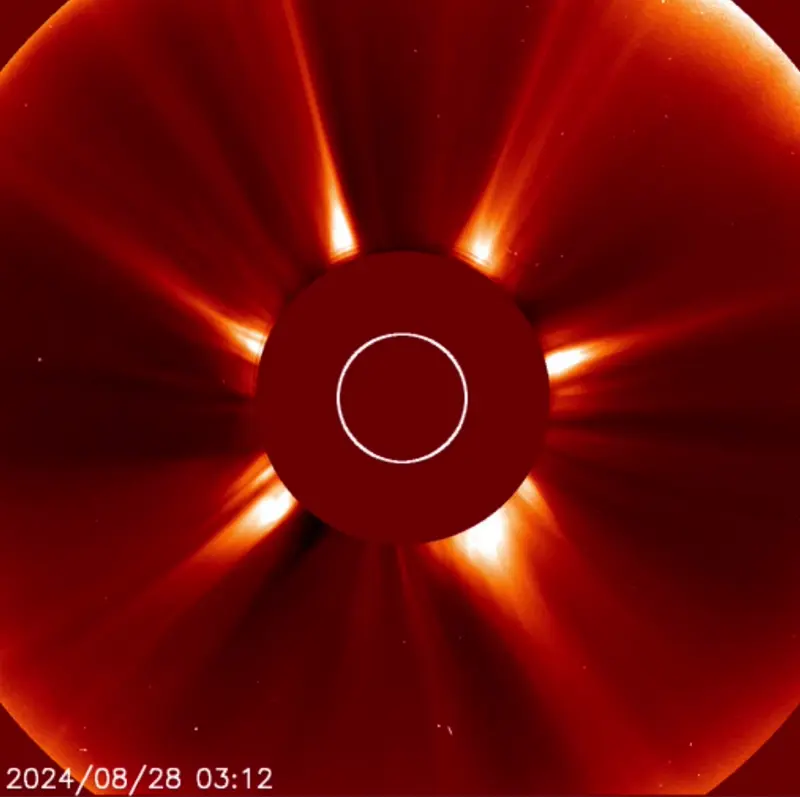
Sun news August 27: That’s more like it! 2 M flares
The sun is now at or near the peak of its 11-year cycle. But we’ve had a relatively quiet couple of days. Now AR3796 has taken the lead in flaring again, with two small M flares. And AR3800 tried its hand with an almost-M flare, a C9.9. Stay tuned.
Last 24 hours: Sun activity is now moderate. We saw two M flares during our observation period, from 11 UTC yesterday to 11 UTC today with a total of 13 flares, two Ms and 11 Cs. The largest was an M1.4 at 11:41 UTC on August 26. Active region AR3796 in the southwest produced it. An R1 (moderate) radio blackout followed the M flare, affecting an area over the Atlantic Ocean. The second M flare of the period was an M1.1 flare, also by AR3796, blasted at 9:43 UTC on August 27. A corresponding R1 (minor) radio blackout was observed over Ethiopia. Region AR3796 remained the lead flare producer with seven of the 12 flares, including the M flares. The sun has 10 active regions on its Earth-facing side. Five regions kept a beta-gamma magnetic configurations: AR3790, AR3796, AR3799, AR3800 and AR3801, though their flaring was less. The remaining regions have simple alpha or beta configurations and remain stable or are in decay.

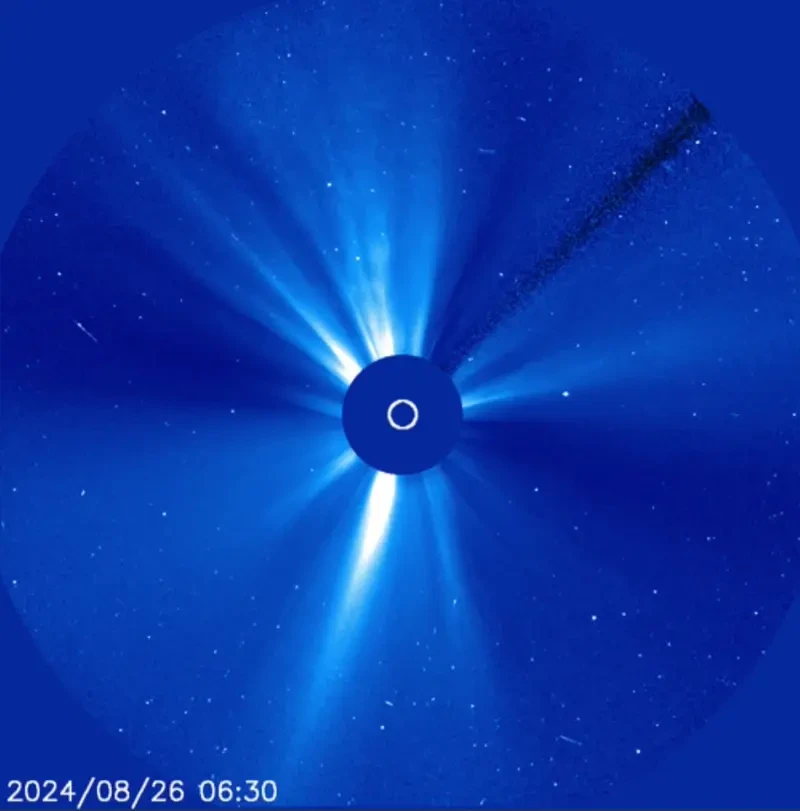
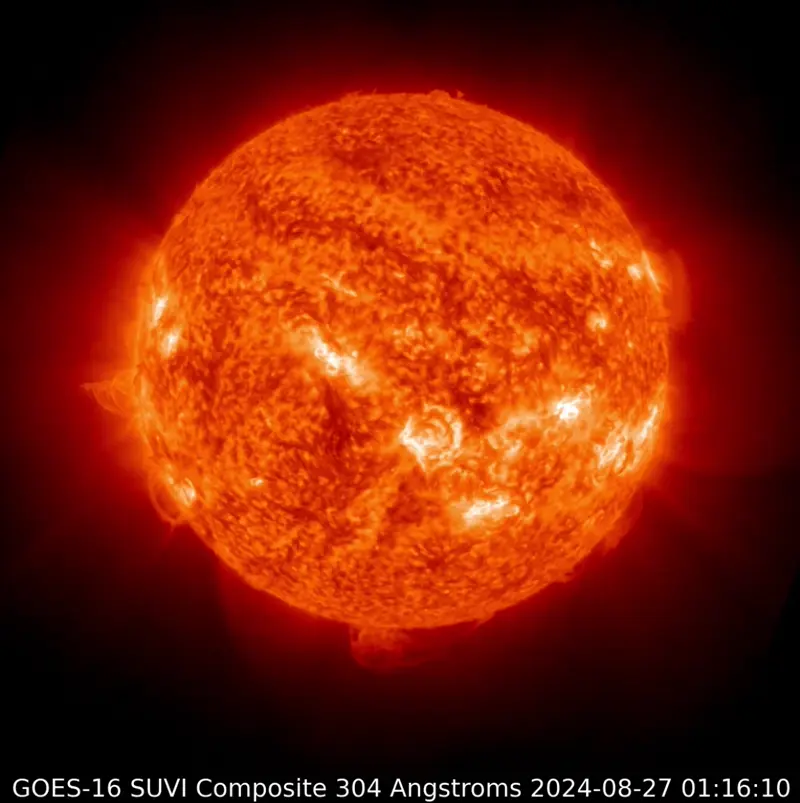

Sun news August 26: Far side regions on their way
Yesterday’s calm has continued, with yet another decrease in activity. Flaring decreased to low levels over the last 24 hours with only C-class events. The most significant event was a C9.1, almost an M flare. But wait, there’s more. As we mentioned yesterday, there’s a hint of activity coming. Via helioseismology – the study of oscillations within the sun itself, principally caused by sound waves driven and damped by the sun’s surface roiling – we can “see” two to three large regions currently on the sun’s far side. If they survive, they should rotate into view in about four to five days. But we might begin to see signs of activity from these regions even sooner, with farside eruptions and flaring. Stay tuned.
Last 24 hours: Solar activity has decreased to low levels in the past day with the production of just C flares. During our observation period from 11 UTC yesterday to 11 UTC today, the sun produced 14 C flares. The largest flare, a C9.1 (almost an M-class) nearly brought activity to moderate levels. This was produced by the most productive region, AR3796, which released five C flares. The sun has eight active regions. Five regions show beta-gamma magnetic configurations: AR3790, AR3796, AR3799, AR3800 and AR3801. The remaining regions have simple alpha or beta configurations and remain stable or are in decay.

Sun news August 25: Hints of increased activity on the way
Happy SunDay! Activity has calmed a bit since the previous 24 hours. With no M5 flare or larger, the current observation period saw overall activity decrease to moderate levels. But even as the solar disk shows a slightly calmer star, the eastern limb (edge) hints at possible action on the horizon. Images from SDO show active coronal loops in the 171-angstrom wavelength and plasma flows in the 304-angstrom wavelength. Stay tuned for more updates.
Last 24 hours: Solar activity reduced to a moderate level in the past day with the production of four M flares. During our observation period from 11 UTC yesterday to 11 UTC today, the sun produced 21 flares: four M and 17 C flares. The largest M was the M1.7 at 23:24 UTC on August 24 from AR3800. An R1 (moderate) radio blackout affected an area over the Pacific Ocean off the west coast of Mexico. Here are the M flares during the observation period:
• M1.0 at 18:58 UTC, August 24 from AR3796. R1 (minor) radio blackout over the Pacific Ocean off the west coast of Mexico.
• M1.4 at 19:30 UTC, August 24 from AR3796. R1 (minor) radio blackout over the Pacific Ocean off the west coast of Mexico.
• M1.3 at 21:46 UTC, August 24 from AR3800. R1 (minor) radio blackout over the Pacific Ocean off the west coast of Mexico.
• M1.7 at 23:24 UTC, August 24 from AR3800. R1 (minor) radio blackout over the Pacific Ocean.
The lead flare producer was AR3800, which produced 14 flares: two M and 12 C flares. On its Earth-facing side, the sun has nine numbered active regions. Five regions show beta-gamma magnetic configurations: AR3790, AR3796, AR3799, AR3800 and AR3801. The remaining regions have simple alpha or beta configurations and remain stable or are in decay. Around 15 UTC on August 24, a filament erupted from the southeast, near AR3796, hurling plasma into space. No Earth-directed coronal mass ejection (CME) was associated with the event.
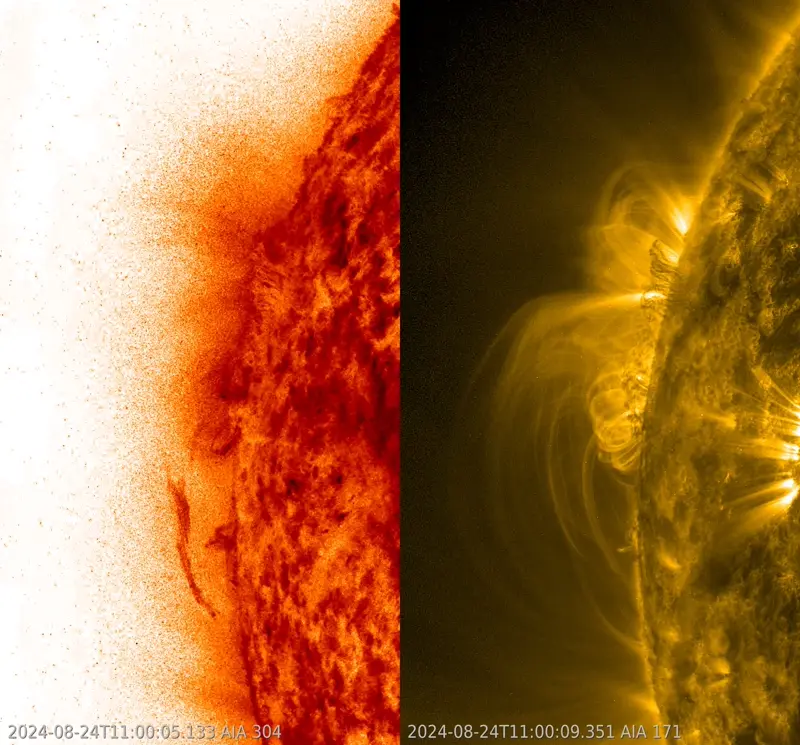
Sun news August 25: Hints of increased activity on the way
Happy SunDay! Activity has calmed a bit since the previous 24 hours. With no M5 flare or larger, the current observation period saw overall activity decrease to moderate levels. But even as the solar disk shows a slightly calmer star, the eastern limb (edge) hints at possible action on the horizon. Images from SDO show active coronal loops in the 171-angstrom wavelength and plasma flows in the 304-angstrom wavelength. Stay tuned for more updates.
Last 24 hours: Solar activity reduced to a moderate level in the past day with the production of four M flares. During our observation period from 11 UTC yesterday to 11 UTC today, the sun produced 21 flares: four M and 17 C flares. The largest M was the M1.7 at 23:24 UTC on August 24 from AR3800. An R1 (moderate) radio blackout affected an area over the Pacific Ocean off the west coast of Mexico. Here are the M flares during the observation period:
• M1.0 at 18:58 UTC, August 24 from AR3796. R1 (minor) radio blackout over the Pacific Ocean off the west coast of Mexico.
• M1.4 at 19:30 UTC, August 24 from AR3796. R1 (minor) radio blackout over the Pacific Ocean off the west coast of Mexico.
• M1.3 at 21:46 UTC, August 24 from AR3800. R1 (minor) radio blackout over the Pacific Ocean off the west coast of Mexico.
• M1.7 at 23:24 UTC, August 24 from AR3800. R1 (minor) radio blackout over the Pacific Ocean.
The lead flare producer was AR3800, which produced 14 flares: two M and 12 C flares. On its Earth-facing side, the sun has nine numbered active regions. Five regions show beta-gamma magnetic configurations: AR3790, AR3796, AR3799, AR3800 and AR3801. The remaining regions have simple alpha or beta configurations and remain stable or are in decay. Around 15 UTC on August 24, a filament erupted from the southeast, near AR3796, hurling plasma into space. No Earth-directed coronal mass ejection (CME) was associated with the event.
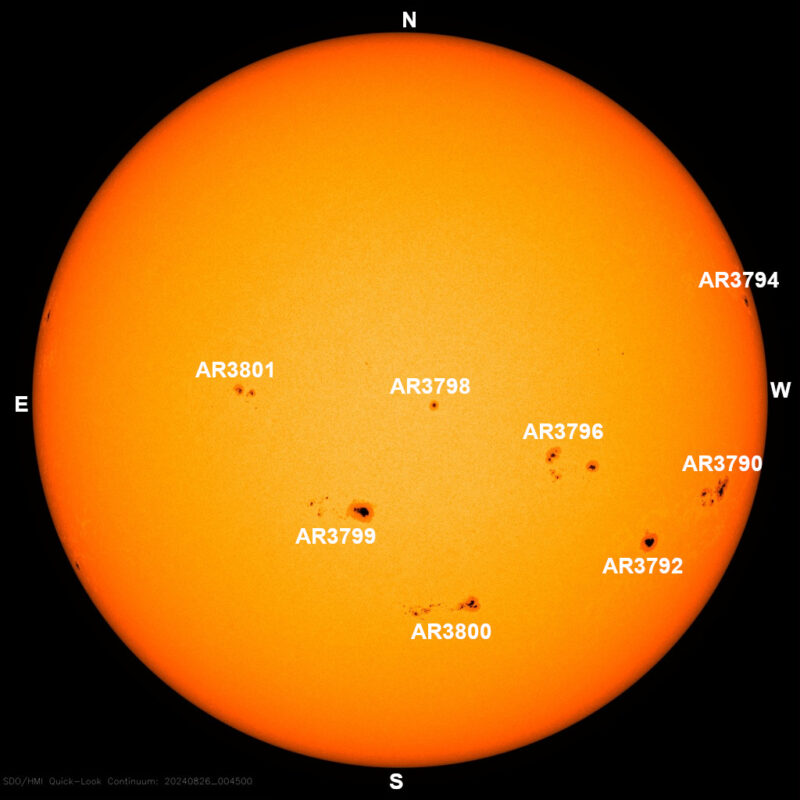

Sun news August 24: Sun activity is high with 8 M flares
The sun activity increased to high thanks to eight M flares, including an M5.1. The newest regions, AR3800 and AR3801, are the sources of most of the current actvitiy. Meanwhile, a plethora of action continues on or near the limb (edge). A filament lifted off near the south pole while prominences danced along the southern limb (edge). Over the north pole, a plasma filament unwinds its twisted magnetic fields, producing a vortex structure northward far into space over the sun. There has not been much coronal mass ejection (CME) activity, but a small eruption from AR3794 could glance Earth around August 27. More to come, so stay tuned.
Last 24 hours: Solar activity jumped to high in the past day with the production of eight M flares, including an M5.1. During our observation period from 11 UTC yesterday to 11 UTC today, the sun produced 23 flares: eight M and 15 C flares. The largest M was the M5.1 at 20:12 UTC on August 23 from AR3800. An R2 (moderate) radio blackout affected an area over the Pacific Ocean west of Hawaii. Here are the M flares during the observation period:
• M1.7 at 13:57 UTC, August 23 from AR3800. R1 (minor) radio blackout over Senegal.
• M1.7 at 15:05 UTC, August 23 from AR3801. R1 (minor) radio blackout over the Atlantic Ocean.
• M1.2 at 16:42 UTC, August 23 from AR3800. R1 (minor) radio blackout over the Caribbean Sea.
• M1.2 at 16:45 UTC, August 23 from AR3800. R1 (minor) radio blackout over the Caribbean Sea.
• M1.1 at 19:33 UTC, August 23 from AR3801. R1 (minor) radio blackout over the Pacific Ocean off the west coast of Mexico.
• M3.4 at 19:44 UTC, August 23 from AR3800. R1 (minor) radio blackout over the Pacific Ocean east of Hawaii.
• M5.1 at 20:12 UTC, August 23 from AR3800. R2 (moderate) radio blackout over the Pacific Ocean west of Hawaii.
• M1.6 at 00:14 UTC, August 24 from AR3796. R1 (minor) radio blackout over the Pacific Ocean.
The lead flare producer was AR3800 with 10 flares: five M, including the M5.1, and five C flares. The sun has nine numbered active regions on its Earth-facing side. Five show beta-gamma magnetic configurations: AR3790, AR3796, AR3799, AR3800 and AR3801. The remaining regions have simple alpha or beta configurations and remain stable or are in decay. Around 3 UTC on August 24, a filament erupted from the Southern Hemisphere, near AR3796, hurling plasma into space.
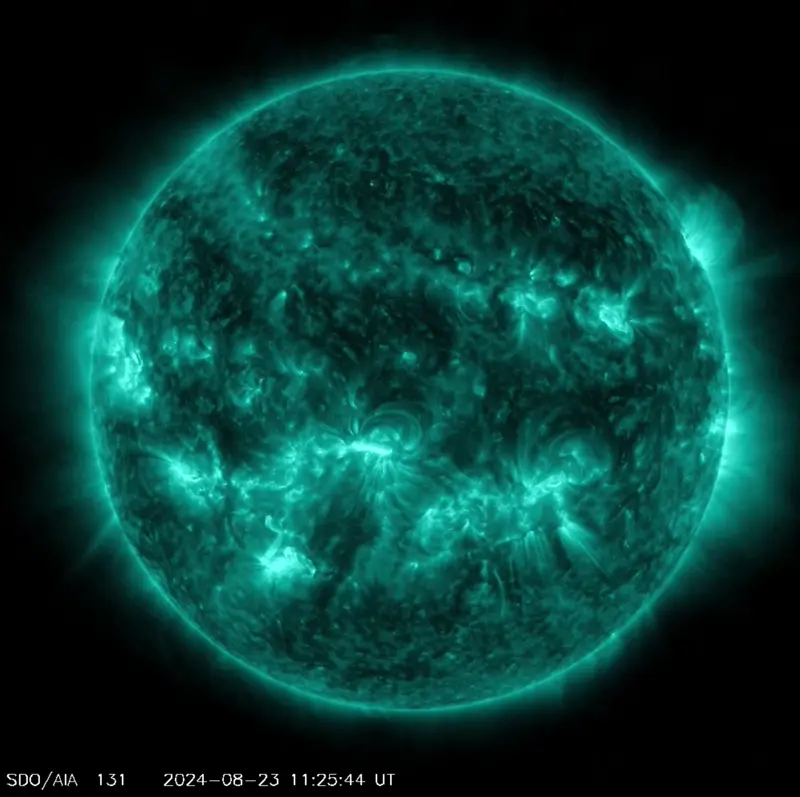

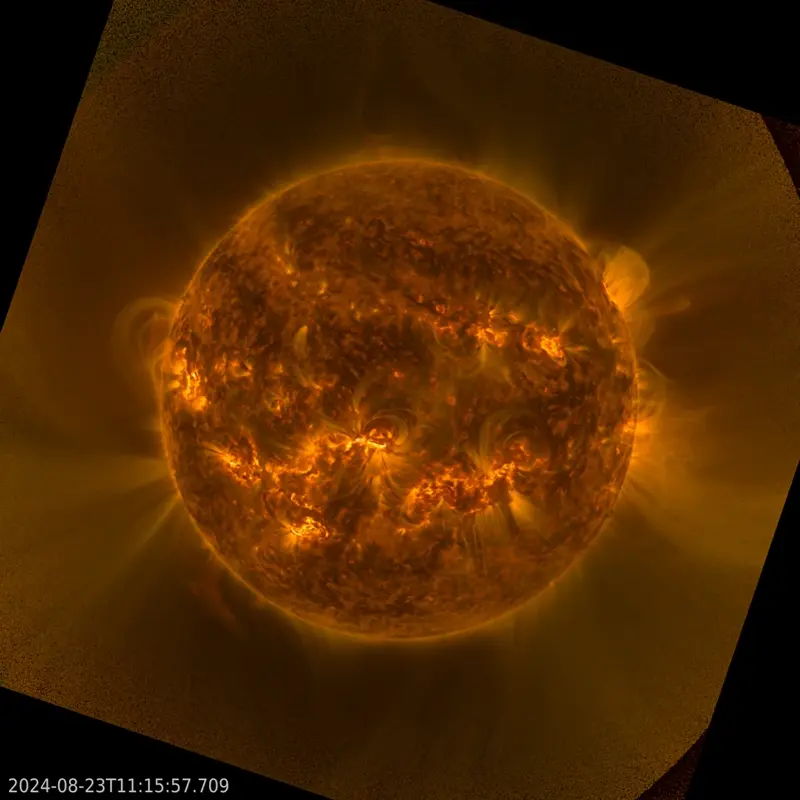
Sun news August 23: Intense activity on the sun’s far side
The sun is very active right now, but all is not what it might seem. Observing our star with the SOHO spacecraft’s LASCO C2 and C3 coronagraphs, one can see a barrage of coronal mass ejections (CMEs) flying into space. But if you look a little closer using extreme-ultraviolet imagery from the Solar Dynamics Observatory (SDO), we see no notable CME activity on the solar disk. Combining all this data into the ENLIL solar system model, the real nature of this activity is revealed: it’s on the sun’s rear side. So the side of the sun facing away from Earth is very active right now, and some of the action could be rotating our way. Using helioseismology to look through the sun reveals that there are many potential active regions soon to rotate onto our side. Stay tuned, as we may see major solar activity in the middle of next week. And, in fact, some of that activity may already be here; today’s largest M flare is from one the newcomer regions, AR3801, which has just rotated into view.
Last 24 hours: Solar activity reduced to moderate levels in the past day with two M flares but flaring production increased notably. During our observation period from 11 UTC yesterday to 11 UTC today, the sun produced 22 flares: two M and 20 C flares. The first and largest M was an M3.5 at 3:41 UTC on August 23 from active region AR3801. An R1 (minor) radio blackout affected an area over the Philippine Sea. The second M was an M1.0 at 4:18 UTC on August 23 from AR3800. An R1 (minor) radio blackout affected the Philippines. The lead flare producer was sunspot region AR3801 with eight flares: the largest M plus seven C flare. Active regions AR3790 and AR3796 retained their beta-gamma magnetic complexities and the largest sized regions are AR3790 and AR3792. The remaining regions have simple alpha or beta configurations and remain stable or are in decay. There are nine numbered active regions on the Earth-facing side. A couple of newcomers, one in the southeast quadrant labeled AR3800 and the incoming region on the northeast limb (edge) we mentioned yesterday, got the second label of the 3800s generation, AR3801. These two groups are very productive and AR3801 is today’s lead flare producer. We have to keep an eye on these active regions.
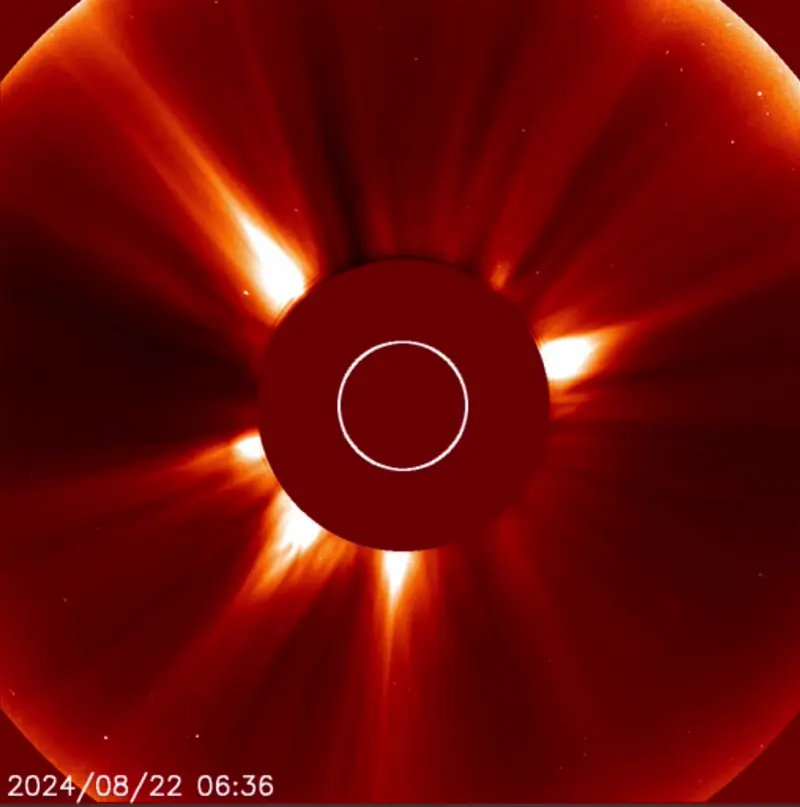

Sun news August 22: Sun activity rises to high
Solar activity has risen to high after sunspot region AR3796 blasted an M5.1 flare. And this is just one of many events taking place on a busy star over the past day. We observed a huge prominence around 7 UTC this morning slightly west of the north pole. AR3789 is still making its presence known, spitting out plasma jets over the northwest limb (edge). All this while a large, more stable prominence continues its dance on the southeast limb (edge) just east of the south pole. And more action seems to be on the way. Helioseismology, in combination with the sight of prominences protruding from the sun’s far side, is suggesting that one or more sunspot regions could soon rotate into view and kick things up a notch. Stay tuned.
Last 24 hours: Solar activity reached high levels during the past day after an M5.1 flare. From 11 UTC yesterday to 11 UTC today the sun produced 15 flares: two Ms and 13 C flares. The largest event was the M5.1 at 22:08 UTC on August 21 from AR3796. A corresponding R2 (moderate) radio blackout affected an area over Hawaii. Sunspot region AR3796 also produced an M1.5 flare at 10:42 UTC, which caused an R1 (minor) radio blackout over Africa. The lead flare producer was region AR3796, which produced five flares: the two Ms plus three Cs. Active region AR3784 rotated over the southwest limb (edge). Regions AR3790 and AR3796 retained their beta-gamma magnetic complexities. The remaining regions on the solar disk have simple alpha or beta configurations. The sun has ten numbered active regions on the Earth-facing side. There is a newcomer in the southeast quadrant labelled AR3799. An incoming region on the northeast limb (edge) may be the first region numbered in the 3800s.
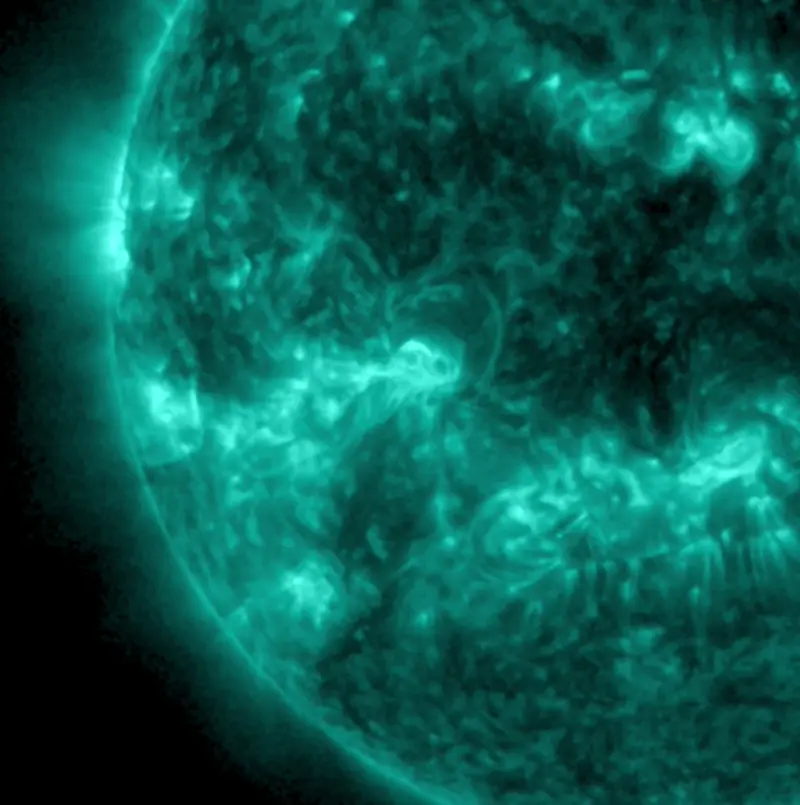

Sun news August 21: Active prominence, increased flaring
An as-of-yet unnumbered region on the southeast limb brings an active prominence region into view with multiple jets of solar stuff. Flare production has increased over the last 24 hours, going from 13 to 24 flares. Two M flares kept sun activity at moderate levels. AR3784 rotates out of view while AR3790 approaches the disk center, the largest region on the sun. Helioseismology shows potential active regions on the sun’s farside that could bring us more Earth-directed activity. Stay tuned.
Last 24 hours: Two M flares observed during our observation from 11 UTC yesterday to 11 UTC today, kept sun activity at moderate levels. The sun produced 25 flares, the two M and 23 C flares. The largest flare was the first M, an M1.3, at 17:08 UTC on August 20 from AR3785. An R1 (minor) radio blackout affected an area over the Atlantic Ocean. The second M was an M1.1 at 6:02 UTC on August 21 from AR3796 with an R1 (minor) radio blackout over the Bay of Bengal. The lead flare producer of the period was sunspot region AR3784, with nine C flares. The sun has 11 numbered active regions. AR3784 lost its delta magnetic complexity due to its position on the northwest solar limb (edge). Because its magnetic field is difficult to measure, it is listed as only a beta-gamma region. Regions AR3790 and AR3796 are beta-gamma regions. The remaining sunspot regions are simple with alpha or beta configurations.

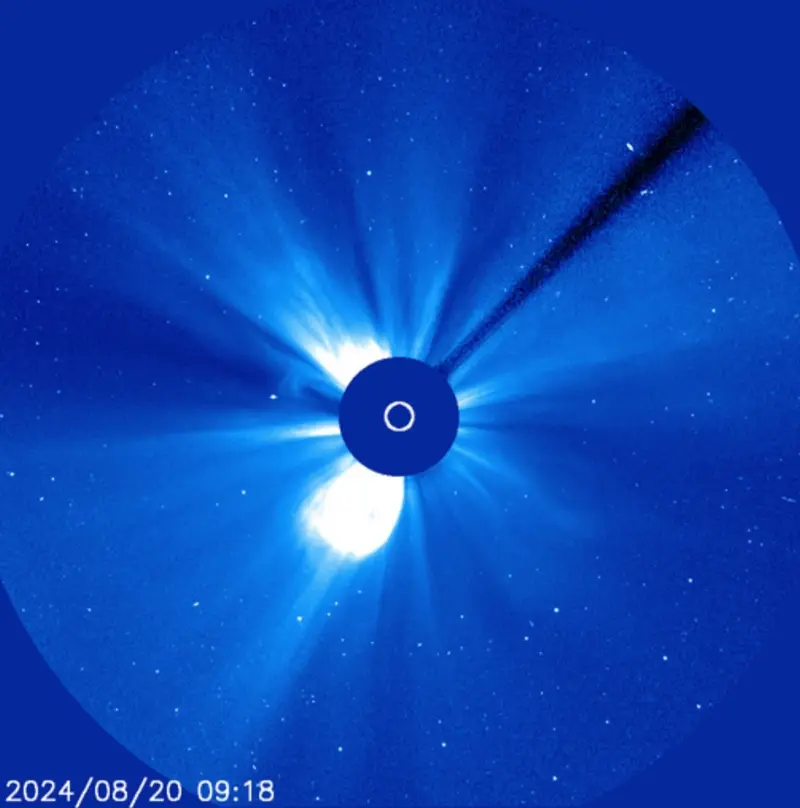
Sun news August 20: Solar activity on the periphery
Once more, over the past day, we’ve seen moderate flaring, with most of the sun activity on our star’s periphery. From 11 UTC yesterday to 11 UTC today, the sun produced three M flares, all from the same sunspot region, AR3796. We also saw dancing, long-lasting prominences on the solar edge, on the sun’s southwestern horizon, the side that the sun’s rotation is now carrying out of view. Stay tuned.
Last 24 hours: Three M flares kept solar activity at moderate in the past day. During our observation period, from 11 UTC yesterday to 11 UTC today, the sun produced 13 flares, three M and 10 C flares. The same active sunspot region produced all three M flares: AR3796. The first was the largest period: an M3.7 flare at 21:52 UTC on August 19. An R1 (minor) radio blackout affected an area of the Pacific Ocean over Hawaii. The lead flare producer was sunspot region AR3796, which, besides the three Ms, produced another three Cs for six flares during the day.
The list of M flares is:
• M3.7 at 21:52 UTC on August 19 from AR3796. R1 (minor) radio blackout over Hawaii. The largest.
• M1.0 at 23:11 UTC on August 19 from AR3796. R1 (minor) radio blackout over the Pacific Ocean west of Hawaii.
• M1.2 at 04:48 UTC on August 20 from AR3796. R1 (minor) radio blackout over Vietnam.
Today, sunspot region AR3784 remains the largest and most magnetically complex, beta-gamma-delta, indicating the possibility of more strong flaring. Now located close to the northwest limb (edge), it will soon rotate out of view. But in the meantime, it could produce more M flares or even an X flare. AR3790 and AR3796 are simpler beta-gamma regions. And the rest of the sunspot regions are stable, with alpha or beta configurations. The sun has 12 active regions, including two new regions, AR3797 and AR3798.

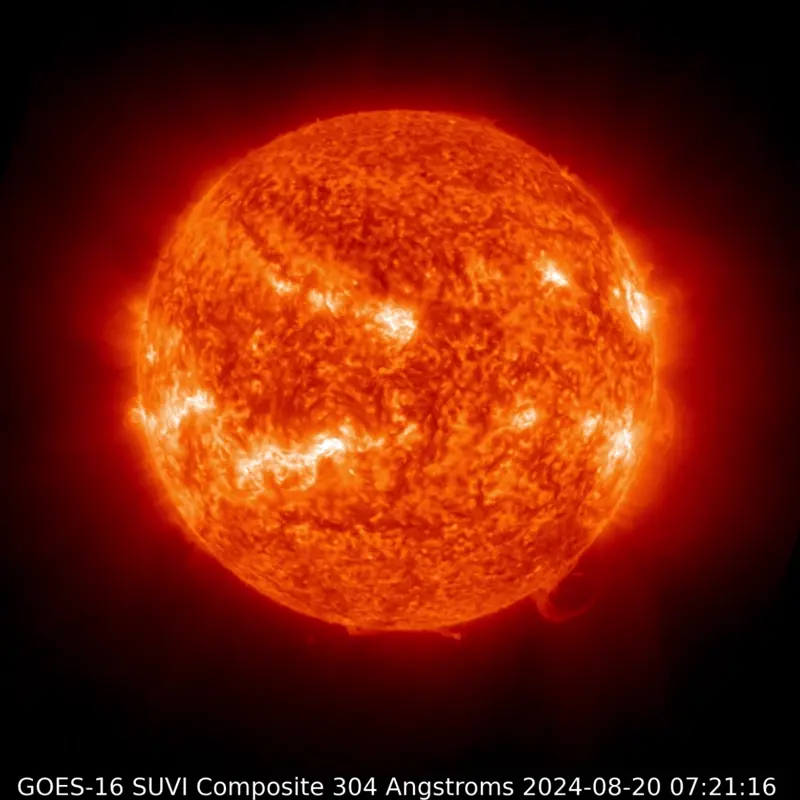
Sun news August 19: An average day on a star at Solar Max
Today is an average day on our active star. That is, the sun is now at or near solar maximum, the peak of its 11-year cycle of activity. Today, flaring is moderate, with three smaller M flares, even though the sun is covered with 11 sunspot groups. The solar limb (edge) has both stable and active prominences and scattered jets of solar stuff shooting out of various active regions. Looking at the sun farther out, several coronal mass ejections (CMEs) are flying into space, but few or none are Earth-directed. An average day on an active star during solar maximum looks like this. Some days and weeks can be filled with multiple forms of high activity. Some days, like today, will only show moderate activity both at the sun and on Earth. These average periods come and go. Enjoy your Monday and stay tuned for the next solar excitement with EarthSky.
Last 24 hours: Sun activity has been moderate during the past day (11 UTC yesterday to 11 UTC today), because of three M flares. The sun produced 12 flares, the three M and nine C flares. All three M flares were M1.4. The first two were from AR3796, and the third from AR3785. All three produced an R1 (minor) radio blackout.
The list of M flares is:
• M1.4 at 21:07 UTC on August 18 from AR3796. R1 (minor) radio blackout over the Pacific Ocean.
• M1.4 at 00:00 UTC on August 19 from AR3796. R1 (minor) radio blackout over the Pacific Ocean.
• M1.4 at 09:36 UTC on August 19 from AR3785. R1 (minor) radio blackout over Africa.
AR3784 region remains the largest and most magnetically complex region on the sun; it still has a beta-gamma-delta magnetic complexity, indicating a possibility for more strong flaring. AR3790 and AR3796 have a slightly simpler beta-gamma region, and the remaining sunspot regions are even simpler, either alpha or beta. In addition to flaring, the sun has a variety of small prominences and looks active around the solar limb (edge). Most notable is a stable prominence on the southern limb (edge) near the pole. Two new regions were numbered AR3795 and AR3796. The sun has 11 active regions on its Earth-facing side.
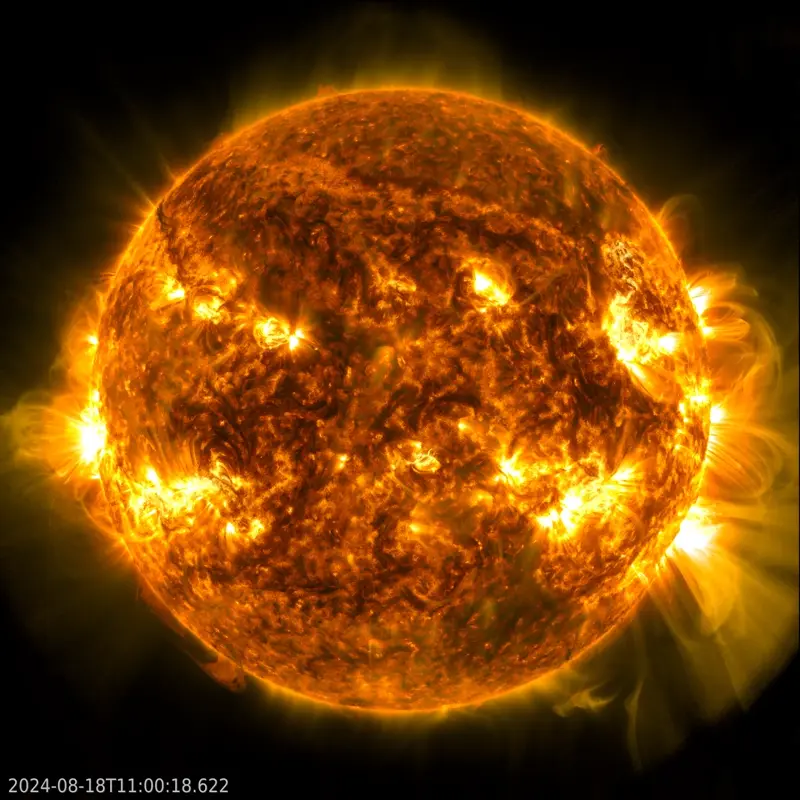
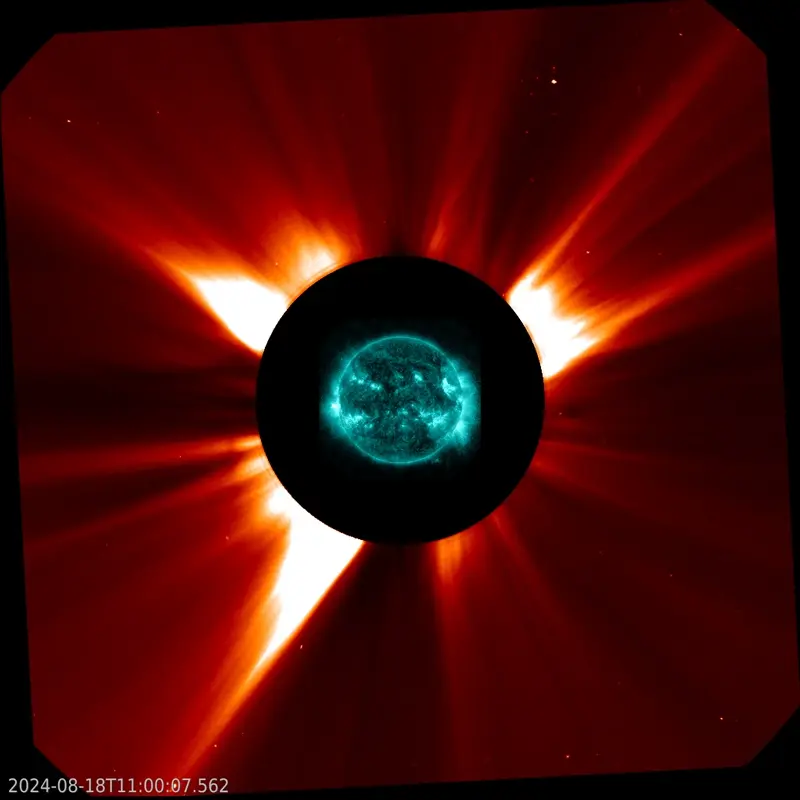
Sun news August 18: Sun-stuff strikes Earth, sparks auroras
Happy Sun Day! The coronal mass ejection (CME) spawned in the August 14 X1.1 flare ended up arriving around 13 UTC on August 17. Ah nature! Sometimes so unpredictable. The impact on Earth’s magnetic environment, the magnetosphere, sparked geomagnetic storms that also exceeded expections. They briefly reached G3 (strong) levels around 17:46 UTC (midday in central North America, early evening in Europe). So the timing of this strike was unfortunate for most of Europe and the Americas, due to the pesky interference of sunlight. Parts of Russia were graced with auroral activity, though.
Last 24 hours: Meanwhile, the sun is blasting away. Sun activity has been moderate during the past day (11 UTC yesterday to 11 UTC today), thanks to six M flares. Overall, the sun produced 13 flares, the four Ms and nine Cs. The largest event of the period was an M2.4 from AR3784. It produced an R1 (minor) radio blackout over the western Pacific Ocean. AR3784 produced the most flares, three Ms and two Cs.
The list of M flares is:
• M1.1 at 11:44 UTC on August 17 from AR3785. R1 (minor) radio blackout over Africa.
• M1.1 at 21:52 UTC on August 17 from AR3790. R1 (minor) radio blackout over the Pacific Ocean.
• M1.4 at 22:06 UTC on August 17 from AR3790. R1 (minor) radio blackout over the Pacific Ocean.
• M2.4 at 02:04 UTC on August 18 from AR3784. R1 (minor) radio blackout over the western Pacific Ocean. The largest.
• M1.1 at 04:16 UTC on August 18 from AR3784. R1 (minor) radio blackout over Southeast Asia.
• M1.3 at 07:30 UTC on August 18 from AR3784. R1 (minor) radio blackout over the Arabian Sea.
AR3784 region remains the largest and most magnetically complex regon on the sun; it still has a beta-gamma-delta magnetic complexity, indicating a possibility for more strong flaring. AR3790 is a slightly calmer beta-gamma region, and the remaining sunspot regions are even simpler, either alpha or beta. In addition to the flaring, we saw some dynamic eruptions just over the northwest and western limbs. The sun has 10 active regions on its Earth-facing side today.
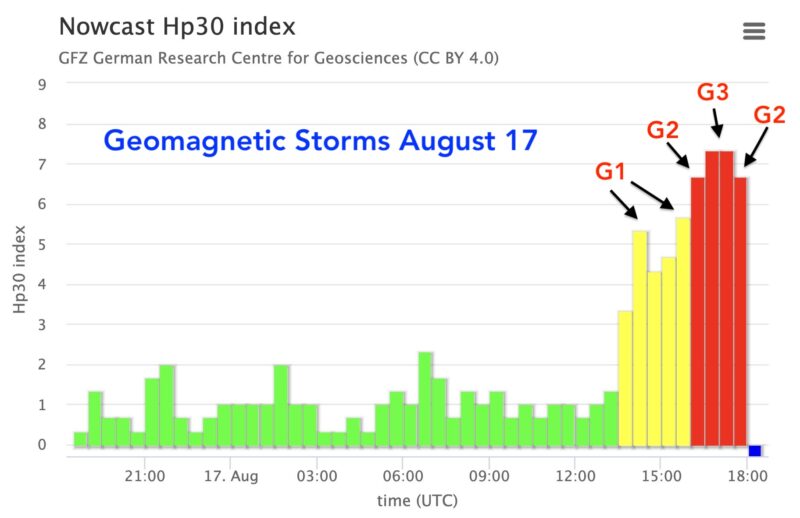
Nice to see Russian cams already have aurora … pic.twitter.com/gAaZ3gDthr
— James Rowley-Hill (@chunder10) August 17, 2024
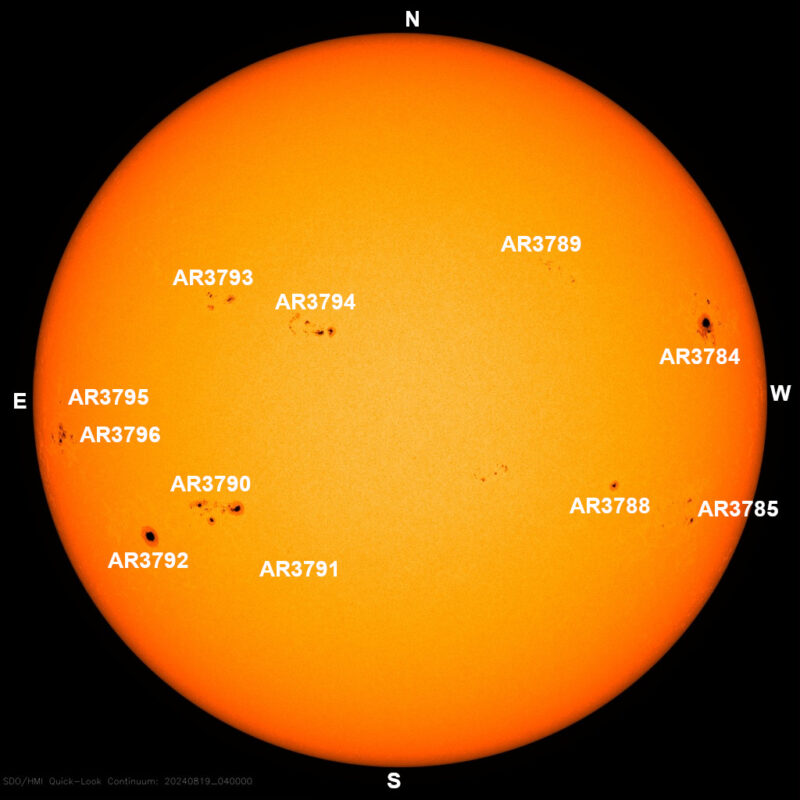
Sun news August 17: Storming from X flare expected overnight tonight
The awaited arrival of the coronal mass ejection (CME) associated with the X1.1 flare on August 14 was expected to arrive at Earth sometime today (August 17). But the aurora forecast shows now 5 UTC on August 18, that is, midnight tonight for central North America. A G1 (minor) geomagnetic storm is anticipated with the arrival of this blob of solar material and magnetic fields. So auroras could be on the way … Meanwhile, on the sun, a third new large coronal hole is forming on the northeast. That means three sources, not two, of fast solar wind from the sun, might also provide conditions for auroral displays. Auroras, come!
Last 24 hours: Sun activity was moderate during the past day (11 UTC yesterday to 11 UTC today), thanks to two M flares. Overall, the sun produced 18 flares, the two Ms plus 16 Cs. An M1.3 flare came from AR3774 at 13:24 UTC on August 16. An R1 (minor) radio blackout affected an area over the Atlantic Ocean off the west coast in Africa. The second M of the period, the largest, was an M1.6 from AR3784 at 10:33 UTC on August 17. It provoked an R1 (minor) radio blackout affecting an area over Chad in Africa. Lead flare producer this time was active region AR3790, which produced eight C flares. So the sun in the past day produced mostly faint C flares. But we also saw jets and exploding filaments on the solar disk, hurling ejecta into space. And we saw long-lasting, dancing prominences on the sun’s periphery. The sun’s east limb (edge), in particular, continued producing gorgeous arched prominences, promising action to come. And the southwest horizon, the side now rotating out of view, had some beautiful prominences, too. Currently, the sun bears nine numbered sunspot regions on its Earth-facing side. Among the nine labeled active regions there are a couple of newcomers on the sun’s southeast quadrant: AR3791 and AR3792. For now, the largest sungroup in extension is AR3784, now located in the sun’s northwest quadrant. It still has its beta-gamma-delta magnetic complexity, too.
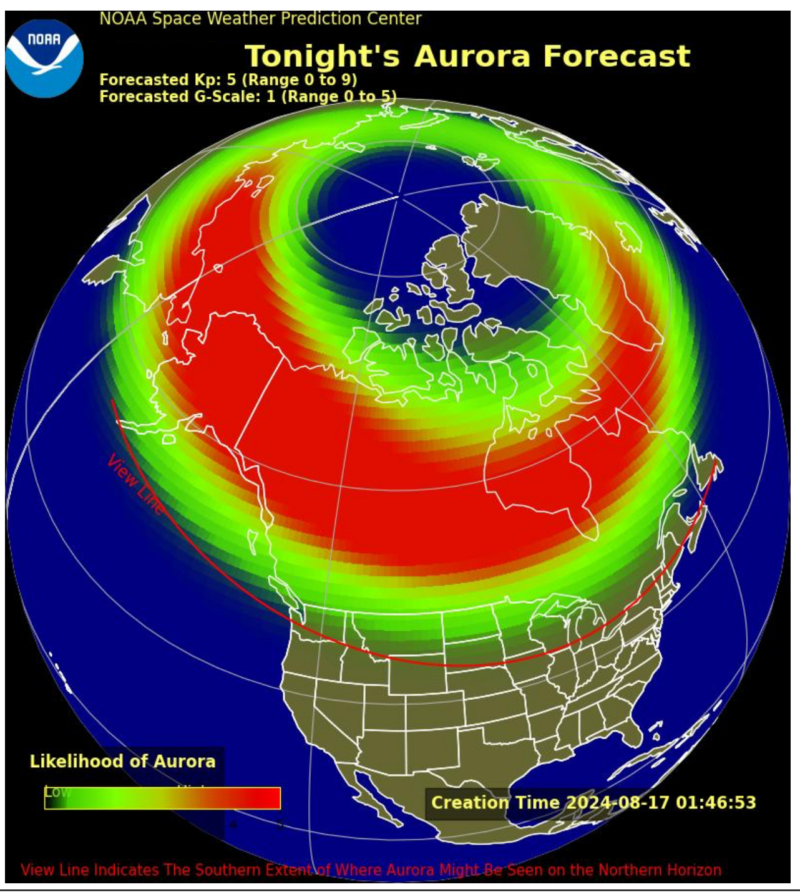
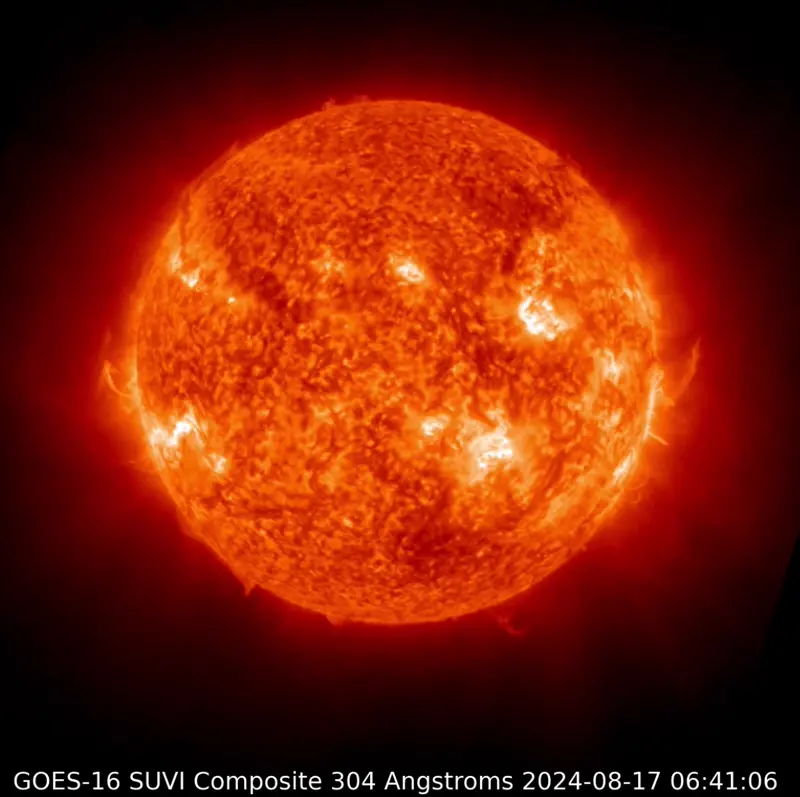
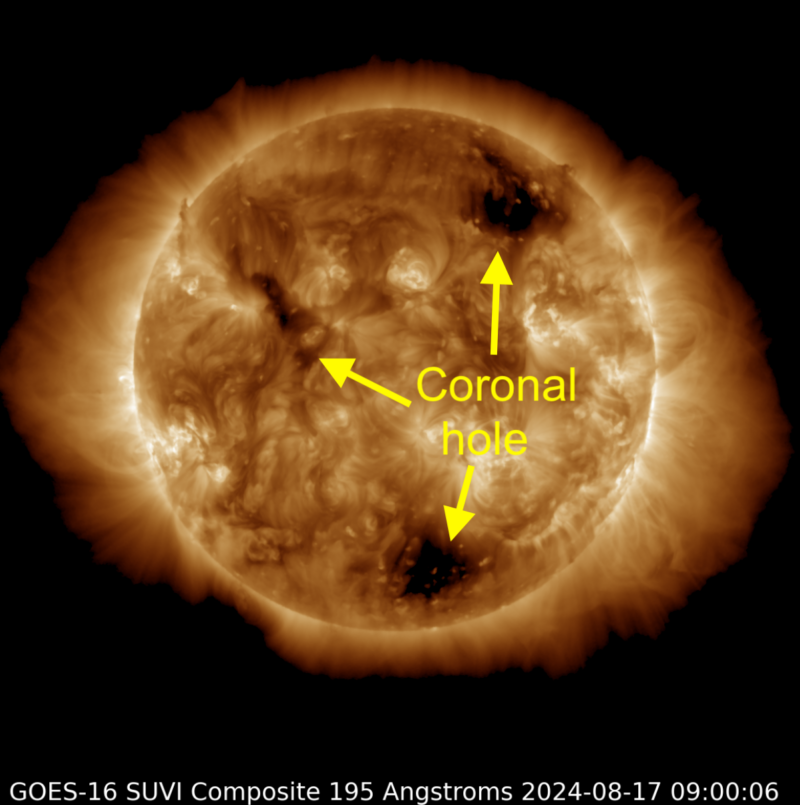
Sun news August 16: X flare sun-stuff expected tomorrow
A coronal mass ejection (CME) produced during the X1.1 flare on August 14 is expected to arrive at Earth late August 17 or early August 18 at the latest. This blob of solar material and magnetic fields was hurled directly towards us, but the flare that sent it was quite short in duration, so we’re only expecting a G1 (minor) geomagnetic storm. But NOAA has issued an aurora alert, so keep an eye out!
Last 24 hours: The sun produced only C flares during the past day, with activity dropping to low. However, long-lasting prominences have been dancing all around the solar horizon. Attracting attention in particular were some gorgeous arcs on the east limb (edge), which indicate that more activity is soon to rotate into view. The total flare production was 16 Cs between 11 UTC yesterday and 11 UTC today. The largest was a C7.8 blasted out by active region AR3786 in the solar southwest. The flare was produced at 17:35 UTC on August 15. The lead flare producer of the period was sunspot region AR3790, which sparked seven C flares. The sun has nine sunspot regions on its Earth-facing side, including a newcomer now labeled AR3790. Most of the sunspot regions on the solar disk appear either stable or in decay, with an alpha or beta magnetic configuration. Only AR3784 keeps its beta-gamma-delta magnetic complexity, meaning it has the potential for more Ms and X flares. A new coronal hole emerged close to the solar south pole, so now we have two large coronal holes sending fast solar wind to us at Earth. The one we have been observing on the northern hemisphere is now geoeffective, meaning its fast solar wind is heading our way at Earth. This increases the chance for us at Earth to see more auroral displays.
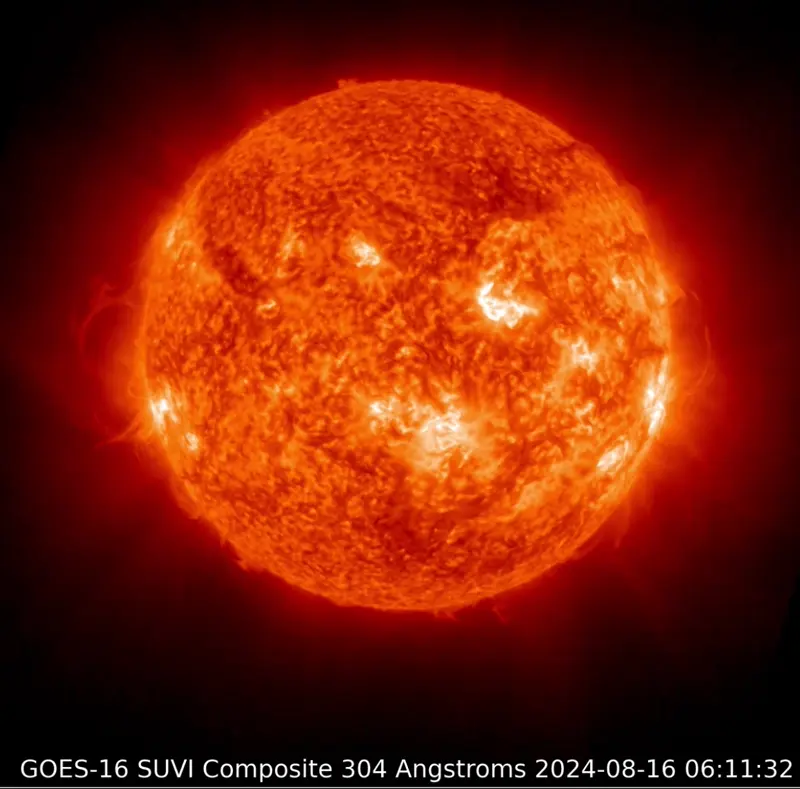
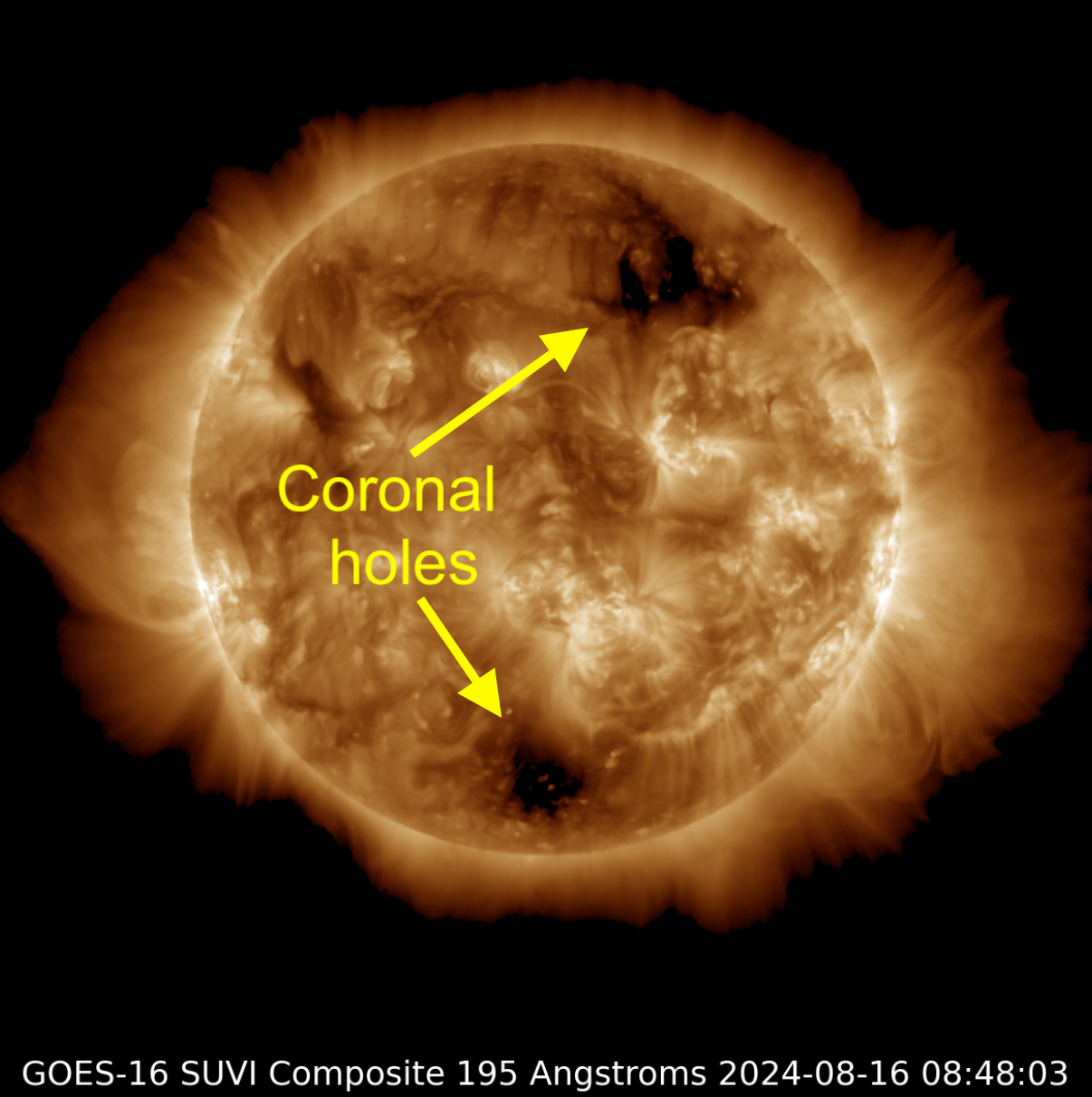
Sun news August 15: Sun-stuff from X flare coming our way
A coronal mass ejection (CME) produced during yesterday’s X1.1 flare event is coming directly our way at Earth. Experts are expecting the bulk of the ejecta to arrive on August 18. But, they say, we could also see an early arrival on August 17. The impact of this solar material with Earth’s magnetic field should boost auroral displays. So clean and polish those camera lenses! And please share your photos with the EarthSky community. By the way, did you see the many images of auroras and Perseids from earlier this week? Wow.
Last 24 hours: Sun activity is still high. And active region AR3784 – producer of the X flare – is still the biggest region on the Earth-facing side of the sun. And it retains its beta-gamma-delta magnetic complexity, meaning it has the potential for more Ms and X flares. Plus it’s still bearing its Hale’s Law-breaking configuration: AR3784 has a vertical magnetic polarity, in contrast to most sunspots (which have a horizontal layout). There’s a second active region with a beta-gamma-delta configuration still on the Earth-facing sun. It’s AR3780, which is about to depart from the sun’s southwest limb (edge). Overall, flare production dropped during the past day (11 UTC yesterday to 11 UTC today), but we did see three M flares, one of them an M5.3. The total for the past day was 10 flares (three Ms, seven Cs) in contrast to yesterday’s 18. AR3784 produced four C flares. And AR3780 produced three flares, an M and two Cs. The sun has nine sunspot regions on its Earth-facing side. There is a newcomer on the solar disk now labeled AR3789. Here’s the list of the M flares:
• M1.1 at 13:24 UTC on August 14 from incoming region in the southeast as-yet-unnumbered. R1 (minor) radio blackout over the Atlantic Ocean off the west coast of Africa.
• M5.3 at 15:49 UTC on August 14 from an incoming region in the southeast as-yet-unnumbered. R2 (moderate) radio blackout in the Caribbean Sea over the British Virgin Islands. The largest.
• M1.1 at 3:48 UTC on Augusts 15 from AR3780. R1 (minor) radio blackout over the Philippines.
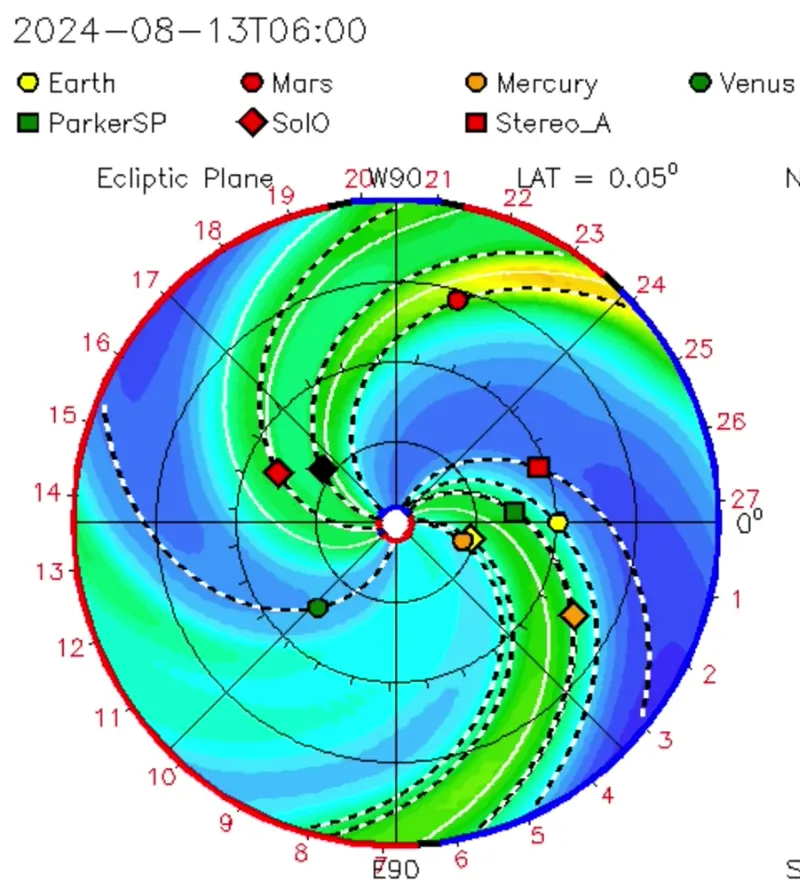
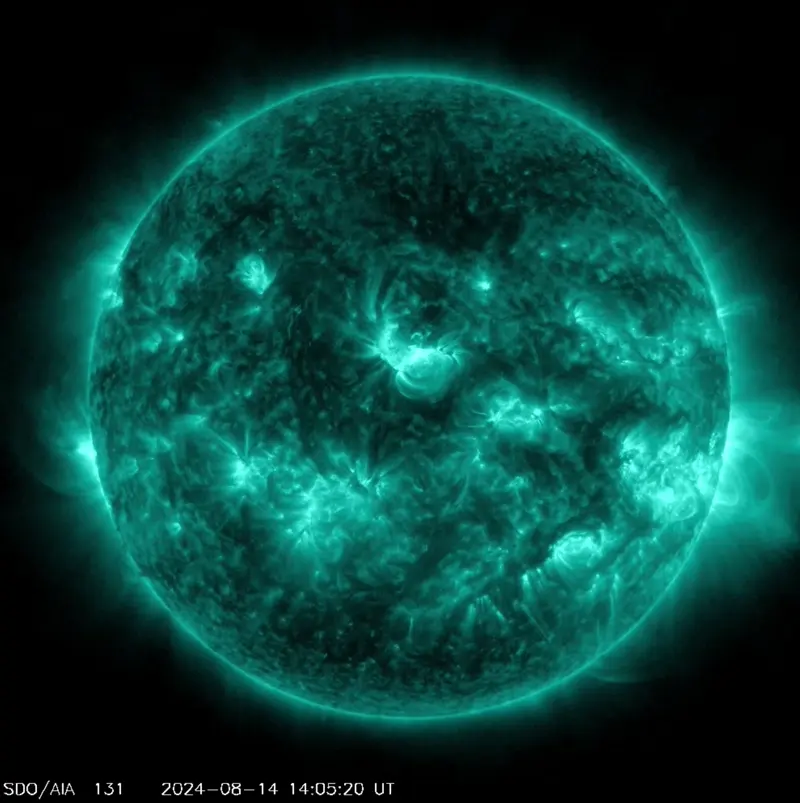
Sun news August 14: Surprise! X1.1 flare
BAM! Sunspot region AR3784 blasted out an X1.1 flare earlier today (6:45 UTC on August 14). The blast provoked an R3 (strong) radio blackout over northeast India. This active region AR3784 is now the largest in extension on the Earth-facing side of the sun. It shows a beta-gamma-delta magnetic complexity, meaning it has the potential for more Ms and X flares. This sunspot region is also breaking Hale’s Law, which applies to the orientation of the magnetic polarity of sunspots. That is, AR3784 is showing a vertical polarity, while horizontal is the common layout. Read more about Hale’s Law here. This different orientation might have created an instability … and the X1.1 flare we just saw today. Stay tuned for more sun news.
Last 24 hours: Sun activity is high, due to this morning’s X1.1 flare by AR3784. Flaring production overall increased from nine flares yesterday up to 18 flares over the past day. The lead flare producer position of the period goes to AR3784, which produced 13 flares, the X1.1 flare, three Ms and nine C flares. The sun has nine sunspot regions on its Earth-facing side. Here’s the list of the X and M flares:
• M1.0 at 17:29 UTC on August 13 from AR3784. R1 (minor) radio blackout over the Caribbean.
• M1.3 at 22:45 UTC on August 13 from AR3777. R1 (minor) radio blackout over Hawaii.
• M1.2 at 22:51 UTC on August 13 from AR3784. R1 (minor) radio blackout over Hawaii.
• M4.2 at 23:44 UTC on August 13 from AR3784. R1 (minor) radio blackout over the Pacific Ocean off the west of Hawaii.
• M4.4 at 4:02 UTC on August 14 from AR3774. R1 (minor) radio blackout over Philippines.
• X1.1 at 6:40 UTC on August 14 from AR3784. R3 (strong) radio blackout over northeast India. The largest.

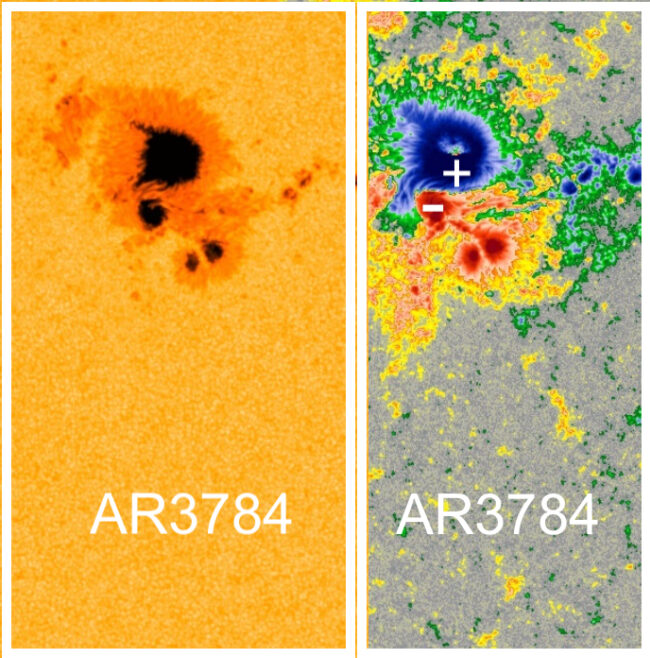
Sun news August 13: Severe geomagnetic storming, auroras … and Perseids!
The geomagnetic storm level went up to G4 (severe) late yesterday (August 12), and more are anticipated today. We hit G4 around 12 UTC on August 12. Geomagnetic storming stayed at G2-G3 (moderate-strong) levels during most of the past day (11 UTC yesterday to 11 UTC today). And so, conditions have been ripe for auroras at northerly latitudes, and as far south as the U.S. states of Iowa, Oregon and California! Along with the auroras for many lucky observers, there were also meteors! The Perseid meteor shower had its peak mornings yesterday and today (August 12 and 13). These two events combined to form an outstanding show. Did you see them? Share your beautiful photos with the EarthSky community! More G1 (minor) geomagnetic storming is expected during the rest of the day today. That means there’ll be chances for more auroras tonight.
Last 24 hours: Solar activity is still at moderate levels thanks to an isolated M flare. It was an M1.2 at 22:57 UTC on August 12 from AR3784. It caused an R1 (minor) radio blackout over the Pacific Ocean west of Hawaii. Overall, flare production dropped in the past day (11 UTC yesterday to 11 UTC today) to only nine flares: an M and eight C flares. Active region AR3784 produced four flares, including the M flare, to become the lead flare producer of the day. The sun has 10 sunspot regions. A large coronal hole has emerged on the north solar hemisphere close to solar north pole.
Sun news August 12: Geomagnetic storms bring auroras
Overnight last night brought an explosion of geomagnetic storms and auroras. Earth’s magnetic field was excited up to G3 (strong) levels with the arrival of several coronal mass ejections (CMEs) from August 7-8 and possibly August 10. There could be more activity to come over today (August 12) into tonight. At the time of this post, the geomagnetic field is storming at the G2 (moderate) level. Watchers may get the excitement of both auroral displays and the Perseid meteor display. Some lucky people already have. Good luck tonight, skywatchers!
Last 24 hours: Sun activity is moderate with two M flares during our observation period between 11 UTC yesterday and 11 UTC today.
The total flare production was 13, two M, and 11 C flares. The largest event was an M1.7 at 20:18 UTC on August 11 from AR3777. It caused an R1 (minor) radio blackout that affected an area over the Pacific Ocean and the western Americas. The list of M flares for the period:
• M1.7 at 20:18 UTC on August 11 from AR3777. R1 (minor) radio blackout over the Pacific Ocean and the western Americas.
• M1.3 at 23:58 UTC on August 11 from AR3780. R1 (minor) radio blackout over the Pacific Ocean.
Active region AR3777 produced six flares including one of the M flares. The sun has 11 sunspot regions. Most of the regions on the disk are stable or in decay. AR3780 retained its delta region with a beta-gamma-delta magnetic complexity. The region remains the largest in size. Several new regions were numbered, AR3785, AR3786, AR3787, and AR3788.
Sun news August 11: Auroras, more tonight, maybe tomorrow
Happy Sun Day! Higher latitudes experienced some auroras last night, as expected, and more geomagnetic activity is expected today into tomorrow August 12, through August 13. A detailed prediction has been challenging for analysts due to the complex barrage of coronal mass ejections (CMEs) leaving the sun from around August 8 until yesterday, August 10. Current flare activity has settled down to moderate, but there could be more on the horizon as helioseismology is indicating several larger magnetic regions on the non-Earth facing side. Keep your aurora hats on for at least tonight and possibly tomorrow night. We are already experiencing a G1 (minor) geomagnetic storm and expect G1 to G2 (minor to moderate) geomagnetic storms through August 12. Stay tuned for more news!
Last 24 hours: Sun activity is moderate with four M flares during our observation period between 11 UTC yesterday and 11 UTC today. The total flare production was 20, four M, and 16 C flares. The largest event was an M1.3 at 14:39 UTC on August 10 from AR3780. It caused an R1 (minor) radio blackout that affected an area over Asia. The list of M flares for the period:
• M1.3 at 14:39 UTC on August 10 from AR3780. R1 (minor) radio blackout over the Atlantic Ocean.
• M1.2 at 15:16 UTC on August 10 from AR3782. R1 (minor) radio blackout over the Atlantic Ocean.
• M1.1 at 00:31 UTC on August 11 from AR3780. R1 (minor) radio blackout over the Pacific Ocean.
• M1.6 at 05:28 UTC on August 11 from AR3780. R1 (minor) radio blackout over Asia.
Active region AR3780 produced 11 flares including 3 of the 4 m flares. The sun has seven sunspot regions. Most of the regions on the disk are stable or in decay. AR3780 is the only region that has retained its delta region with a beta-gamma-delta magnetic complexity. The region remains the largest in size. Several new regions observed via helioseismology may soon rotate into view.
Active region AR3780 blasted out 11 flares. Out of its 11 flares, seven were M flares and the rest were Cs, so the title for lead flare producer goes to this sunspot region. Today, the sun bears nine active regions on the Earth-facing side. A newcomer in the northeast limb (edge) is now labeled AR3784. This one has been flaring since yesterday, even before getting a number. Yesterday, this newcomer shared honors of lead flare producer along with sunspot region AR3780. By the way, AR3780 continues growing and is the largest in extension on the Earth-facing solar disk. It has grown to an area of approximately 8 Earths, still visible from Earth without magnification, as long as you wear the correct eye protection.
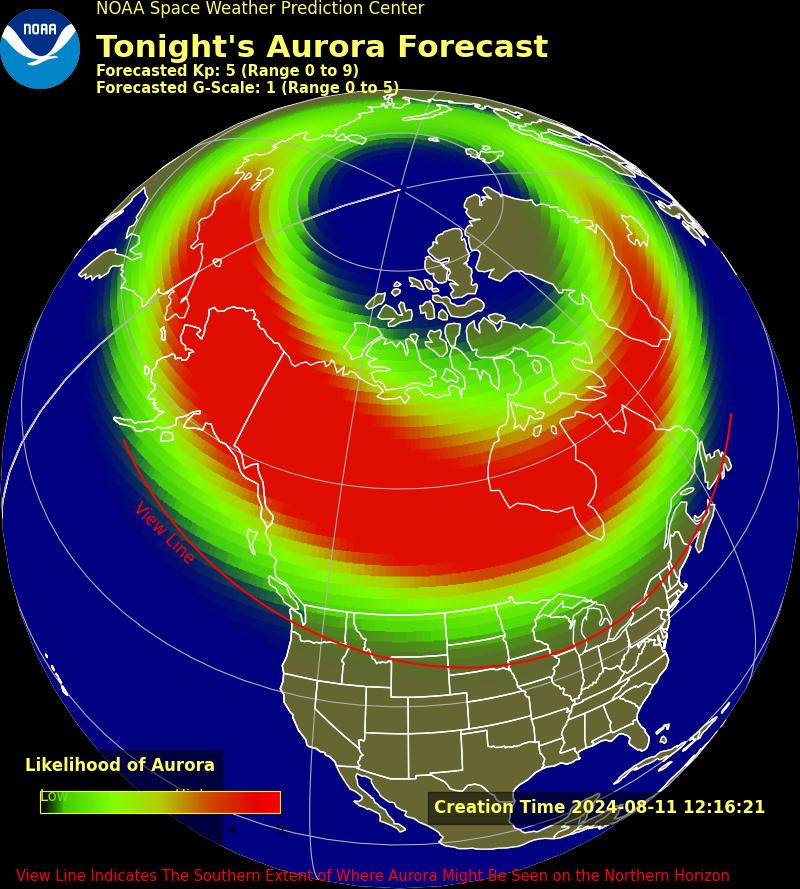
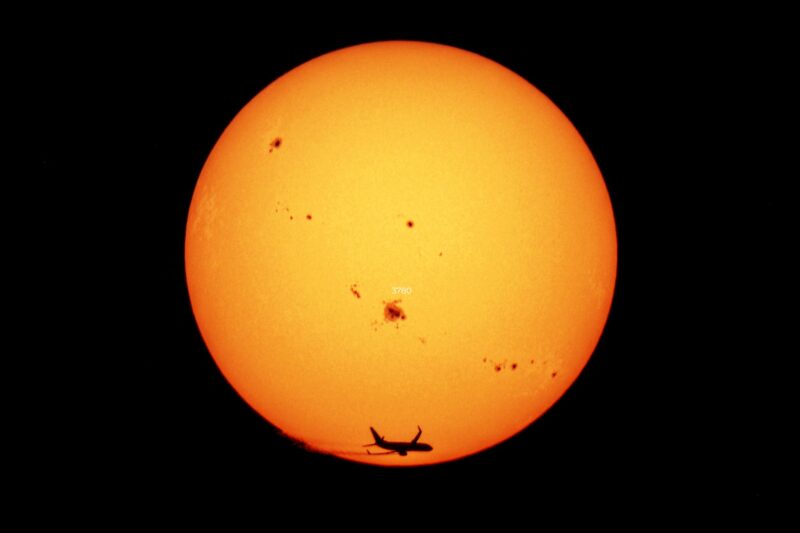

Sun news August 10: Auroral displays anticipated tonight and tomorrow
Auroral displays are expected to occur tonight and tomorrow night with the arrival of multiple coronal mass ejections (CMEs) that left the sun on August 8. A G1 to G2 (minor to moderate) geomagnetic storm is anticipated. The high level of solar activity we saw earlier provoked blobs of sun stuff and a portion of all that solar material is headed our way and may provoke beautiful auroras. Also, after modeling and analysis, specialists found a component headed our way coming from the X1.3 flare we saw yesterday and the CME associated with this event. An arrival of this plasma may occur late on August 11 or early August 12, so a weekend with auroral activity is expected. Clear skies for you aurora chasers! Turning our head back to the sun, we noticed that all five active regions bearing the highest magnetic complexity, a beta-gamma-delta, all decayed, and today, only AR3777 and AR3780 show a beta-gamma configuration. The rest show alpha or beta configurations. Flaring activity during our observation period was high and we saw more M flares than Cs. Read all the information below. Stay tuned.
Last 24 hours: 11 M flares in the past day puts sun activity at a high level. During our observation period between 11 UTC yesterday and 11 UTC today, solar flare production was at a total of 18 flares. And we saw more M flares than C flares. During that period there were 11 M flares produced and 7 Cs. The largest flare was an M5.3 at 2:37 UTC on August 10 from AR3780. The event provoked a long duration R2 (moderate) radio blackout that affected an area over the Philippine Sea. This is the list of M flares for the period:
• M1.2 at 11:17 UTC on August 9 from AR3780. R1 (minor) radio blackout over Algeria.
• M1.4 at 12.06 UTC on August 9 from AR3780. R1 (minor) radio blackout over Morocco.
• M1.0 at 12:43 UTC on August 9 from AR3781. R1 (minor) radio blackout over the Atlantic Ocean off the west coast of Africa.
• M1.0 at 12.59 UTC on August 9 from AR3780. R1 (minor) radio blackout over the Atlantic Ocean off the northwest coast of Africa.
• M1.0 at 20:37 UTC on August 9 from AR3779. R1 (minor) radio blackout over the Pacific Ocean.
• M4.6 at 21:23 UTC on August 9 from AR3774. R1 (minor) radio blackout over the Pacific Ocean east of Hawaii.
• M2.9 at 22.03 UTC on August 9 from incoming region NE. R1 (minor) radio blackout over Hawaii.
• M1.1 at 23:50 UTC on August 9 from AR3780. R1 (minor) radio blackout over the Pacific Ocean off the west coast of Hawaii.
• M1.3 at 1:02 UTC on August 10 from AR3780. R1 (minor) radio blackout over west Pacific Ocean.
• M5.3 at 2:37 UTC on August 10 from AR3780. R2 (moderate) radio blackout over the Philippine Sea. The Largest.
• M1.6 at 4:11 UTC on August 10 from AR3780. R1 (minor) radio blackout over the South China Sea.
Active region AR3780 blasted out 11 flares. Out of its 11 flares, seven were M flares and the rest were Cs, so the title for lead flare producer goes to this sunspot region. Today, the sun bears nine active regions on the Earth-facing side. A newcomer in the northeast limb (edge) is now labeled AR3784. This one has been flaring since yesterday, even before getting a number. Yesterday, this newcomer shared honors of lead flare producer along with sunspot region AR3780. By the way, AR3780 continues growing and is the largest in extension on the Earth-facing solar disk. It has grown to an area of approximately 8 Earths, still visible from Earth without magnification, as long as you wear the correct eye protection.
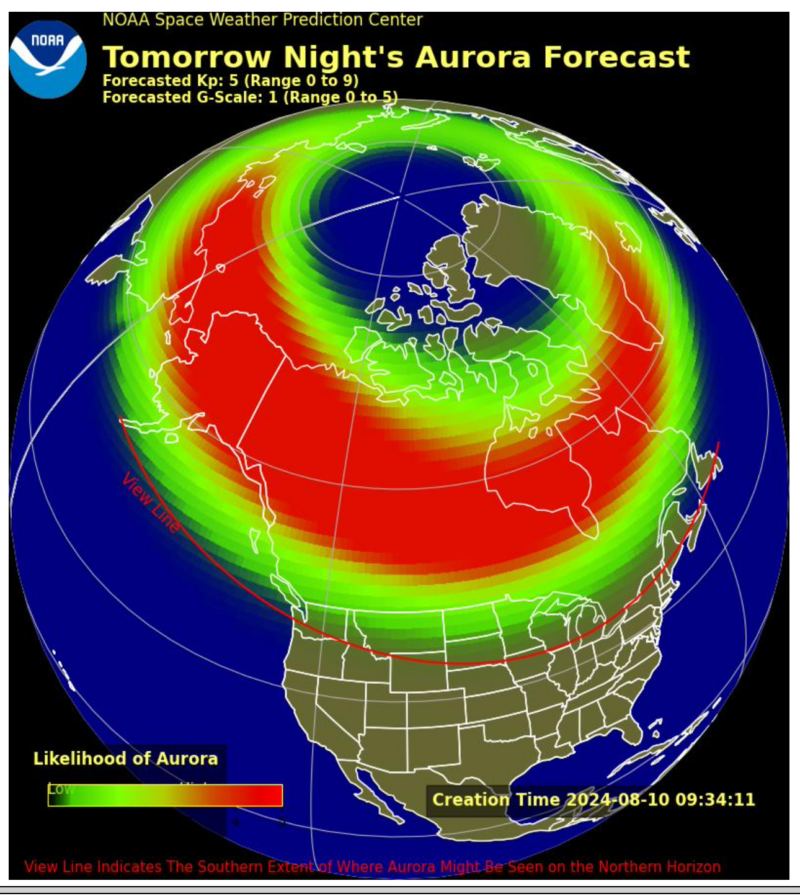


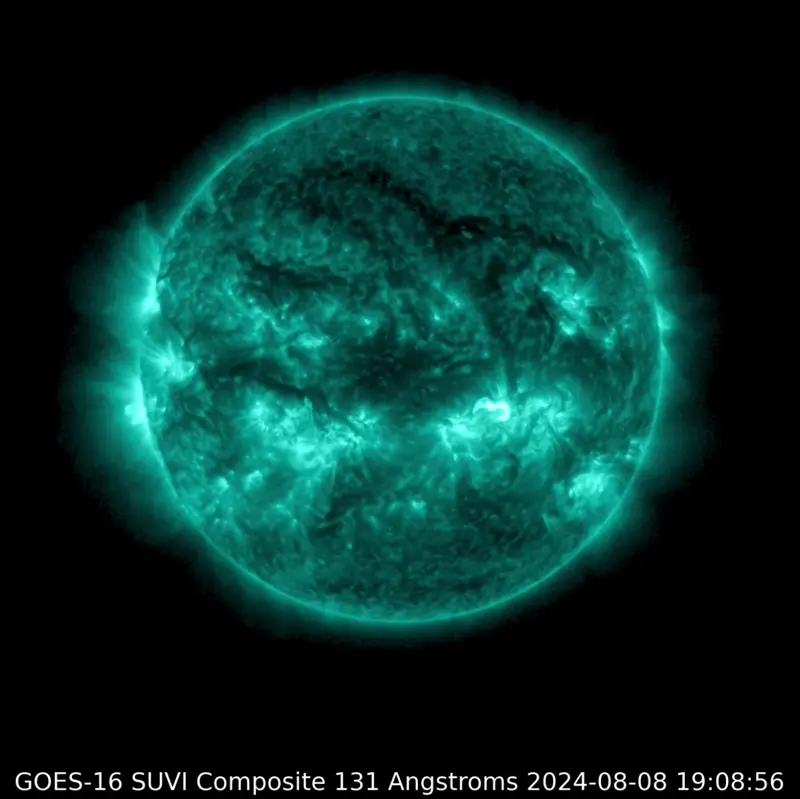
Sun news August 9: Kaboom, X flare! Aurora alert issued
X flare! Sunspot region AR3777 released an X1.3 flare at 19:35 UTC on August 8. It was just a matter of time before we saw a big flare like this, considering that yesterday we could see five active regions with the highest level of magnetic complexity: beta-gamma-delta. That means a region is a prime candidate to produce M and X flares, and that’s exactly what we got: an X flare plus five more M flares over the past day, keeping activity high. And the recent action on the sun is set to bring some action to Earth this weekend. NOAA issued a G2 (moderate) geomagnetic storm watch for later today through tomorrow. Keep an eye out for auroras!
Last 24 hours: An X flare kept sun activity high over the past day. Active region AR3777 produced the X1.3 flare at 19:35 UTC on August 8. An R3 (strong) radio blackout affected an area over the Pacific Ocean off the west coast of Mexico. Between 11 UTC yesterday and 11 UTC today we saw a total of 17 flares: one X, five Ms and 11 C flares. The list of the X and M flares for the period is:
• M1.6 at 11:42 UTC on August 8 from AR3777. R1 (minor) radio blackout over Algeria.
• M1.0 at 12:13 UTC on August 8 from AR3781. R1 (minor) radio blackout over Morocco.
• M1.0 at 13:00 UTC on August 8 from AR3781. R1 (minor) radio blackout over the Atlantic Ocean off the northwest coast of Africa.
• M1.5 at 13:43 UTC on August 8 from incoming region SE. R1 (minor) radio blackout over the Atlantic Ocean in Cabo Verde Islands.
• X1.3 at 19:35 UTC on August 8 from AR3777. R3 (strong) radio blackout over the Pacific Ocean off the west coast of Mexico. The largest.
• M1.2 at 22:51 UTC on August 8 from AR3780. R1 (minor) radio blackout over the Pacific Ocean southwest of Hawaii.
The lead flare producers for the period are active regions AR3777, AR3780, and an as-yet-unnumbered incoming region on the southeast, each producing four flares. The sun currently has eight active regions on the Earth-facing side. A newcomer in the northeast quadrant is now labeled AR3783. Sunspot region AR3780 has grown to an area of approximately 8 Earths. It is the largest sunspot region on the sun and is visible from Earth without magnification, as long as you wear the correct eye protection.
? ? ? Kaboom!! An X1.3 flare is currently underway. It peaked around 19:57 UTC from AR3777. More to come! ? ? ? #spaceweather #solarmax pic.twitter.com/dw9dS8FAGz
— Dr. C. Alex Young (@TheSunToday) August 8, 2024


Sun news August 8: Wow! Even more high-potential regions
Yesterday, we reported that three sunspot regions are showing very high flaring potential. A day later, two more have been added to the list! Active regions AR3772, AR3774, AR3777, AR3780, and AR3781 are all displaying the highest level of magnetic complexity, beta-gamma-delta, meaning they have the potential for M and X flares. Solar activity has risen to high after four M flares were fired over the past day, but even bigger sparks may be building up under those beta-gamma-delta regions. Stay tuned!
Last 24 hours: Solar activity increased to high over the past day with the production of four M flares including an M5. Between 11 UTC yesterday and 11 UTC today we saw a total of 19 flares: four M and 15 C flares. The largest flare was an M5 produced by active region AR3774 at 18:54 UTC on August 7. The list of M flares for the period is:
• M4.5 at 13:50 UTC on August 7 from AR3774. R1 (minor) radio blackout over the Atlantic Ocean.
• M5.0 at 18:54 UTC on August 7 from AR3777. R2 (moderate) radio blackout over Mexico. The largest.
• M2.1 at 1:06 UTC on August 8 from AR3777. R1 (minor) radio blackout over the west Pacific Ocean.
• M1.3 at 4:40 UTC on August 8 from AR3777. R1 (minor) radio blackout over the South China Sea.
The title of lead flare producer for the period was shared by two active regions, AR3777 and AR3780, each with seven flares. AR3777 produced three M flares, including the largest of the period. The sun currently has eight active regions on its Earth-facing side. A newcomer on the east limb (edge) is now labeled AR3782. AR380 is the largest sunspot region on the sun, and is visible from Earth without magnification as long as you be sure to wear the correct eye protection.
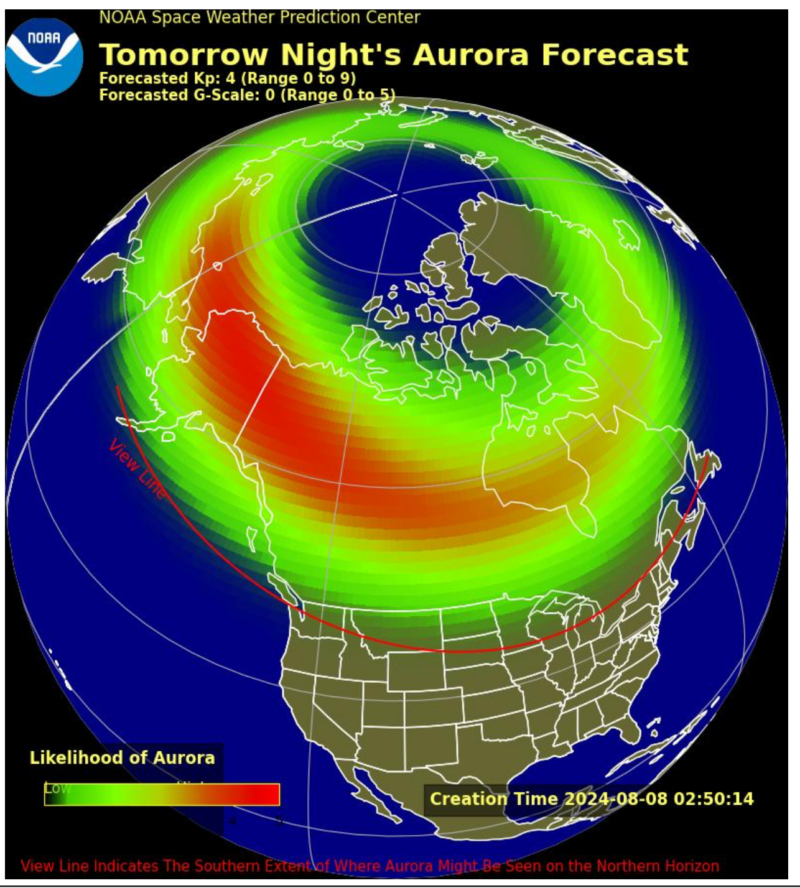
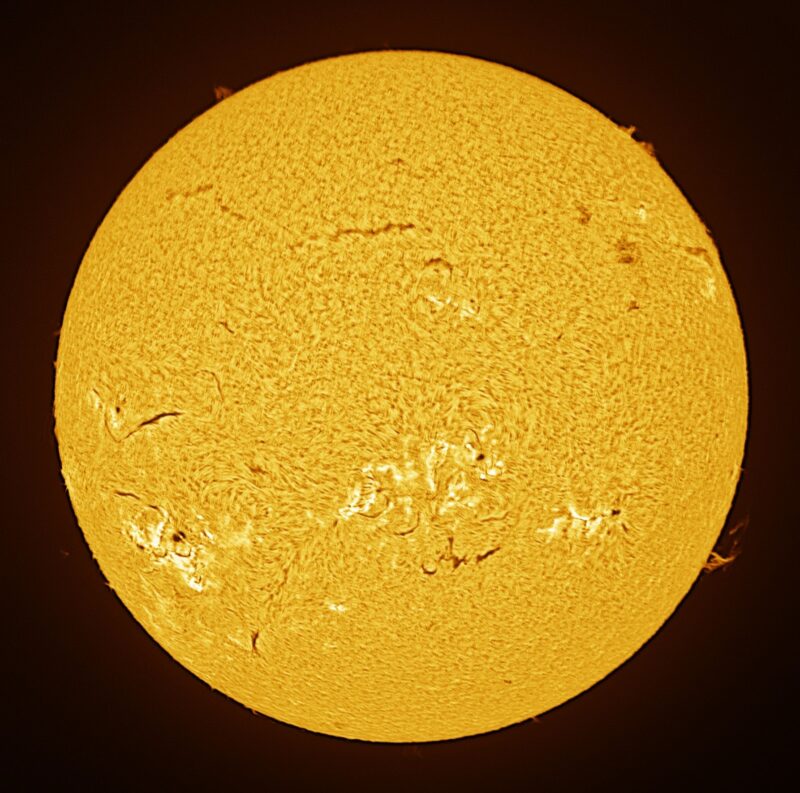
Sun news August 7: Sunspot regions showing huge potential
Three of the eight sunspot regions visible on the sun right now are showing some serious potential. These groups – AR3774, AR3777, and AR3780 – are displaying the highest level of magnetic complexity, beta-gamma-delta, meaning they have the potential to produce big M flares and X flares. One of these regions, AR3780, is the largest on the Earth-facing sun. It can even be seen without magnification from Earth as long as you be sure to wear the correct eye protection. Put on your eclipse glasses and take a look at the sun, and you’ll see a sunspot region that could be bringing us some major activity in the coming days!
Last 24 hours: Despite the potential of the abovementioned sunspot groups, the sun seems to have taken a day off from its recent high activity. With 14 flares fired over the past day (two M flares and 12 C flares), solar activity has dropped to moderate. Between 11 UTC yesterday and 11 UTC today, the largest flare was an M1.8 flare from AR3774 at 2:30 UTC on August 7. A corresponding R1 (minor) radio blackout affected an area over the Philippine Sea. The second M flare was an M1.1 from sunspot region AR3781 at 4:57 UTC on August 7, producing an R1 (minor) radio blackout over Hanoi in China. The lead flare producer was active region AR3774 with six flares (one M and five C flares). The sun currently has eight active regions on its Earth-facing side. Three active regions, AR3774, AR3777 and AR3780, show a beta-gamma-delta configuration. AR3772 kept its beta-gamma magnetic complexity, while AR3781 is showing a beta-delta configuration.
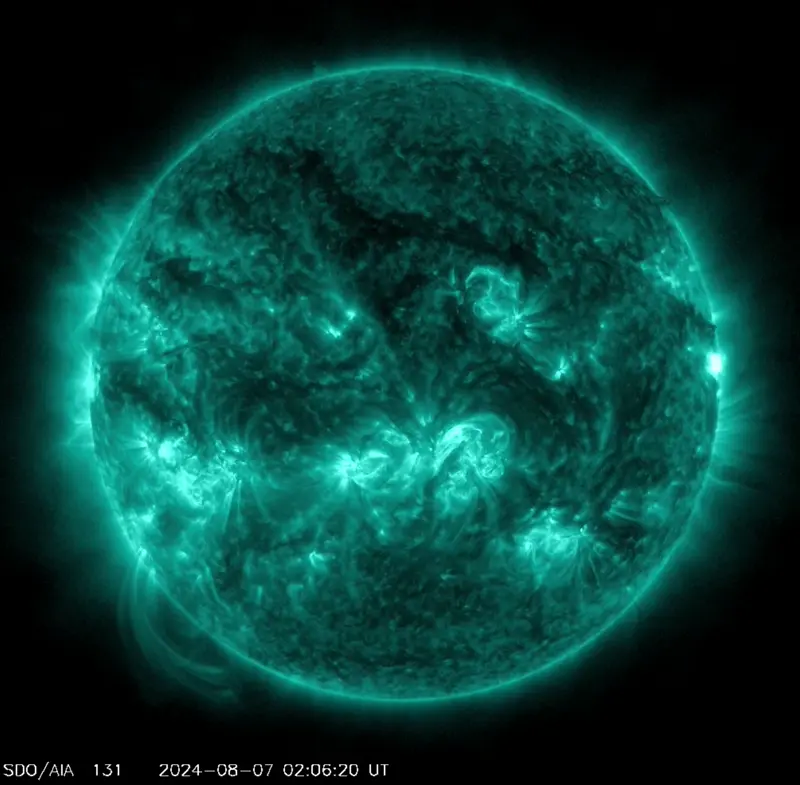
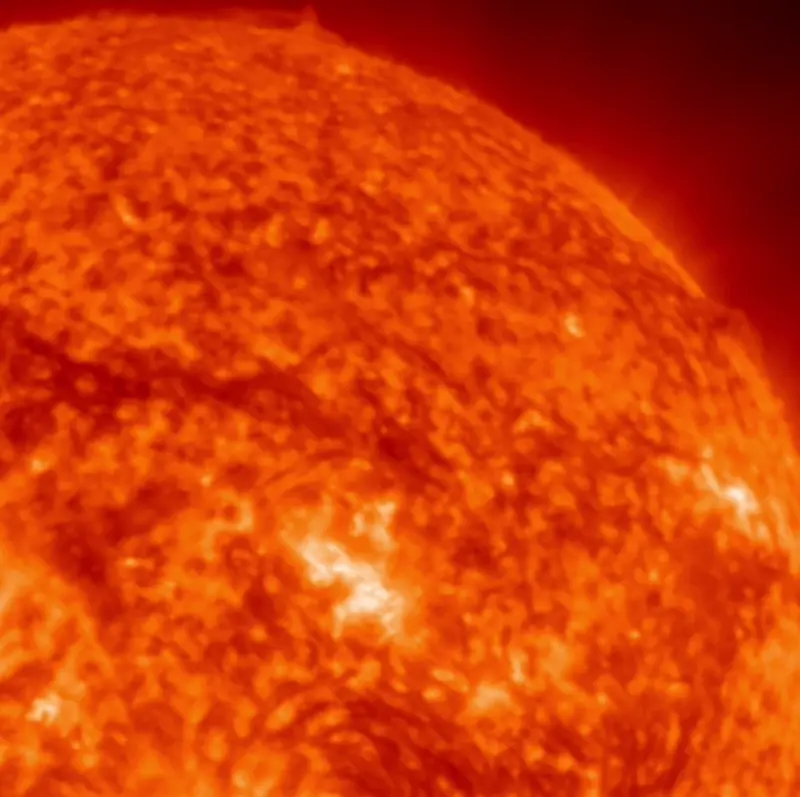

Sun news August 6: Bam! Bam! 2 X flares in 2 hours
X flares are the most powerful solar flares. And two sunspot regions – AR3767 and AR3780 – each produced an X flare, in a less than 2-hour period yesterday. The first and larger was an X1.7 at 13:40 UTC on August 5 from AR3767. The second was an X1.2 at 15:27 UTC on August 5 by AR3780. And these two flares were on opposite sides of the sun! AR3767 departed over the sun’s southwest limb (edge) afterwards, as AR3780 rolled into view in the sun’s southeast. And this mighty region, AR3780, is now the largest active region on the sun, in both size and magnetic complexity (it has a beta-gamma-delta configuration). This region is just beginning its journey across the sun’s Earth-facing disk. We’ll keep watching it to see what’s in store. Stay tuned for more sun news.
Last 24 hours: The two August 5 X flares kept solar activity at high. During our observation period, between 11 UTC yesterday and 11 UTC today, the sun produced two X and three M flares. The sun produced 17 flares in the past day: Two X, three M and 12 C flares. The largest flare was an X1.7 from AR3767 on the southwest limb (edge) at 13:40 UTC on August 5. The list of X and M flares is:
• X1.7 at 13:40 UTC on August 5 from AR3767. R3 (strong) radio blackout over the Atlantic Ocean off the west coast of Africa.
• X1.2 at 15:27 UTC on August 5 from AR3780. R3 (strong) radio blackout over the middle of the Atlantic Ocean.
• M1.0 at 18:02 UTC on August 5 from AR3767. R1 (minor) radio blackout over the Gulf of Mexico.
• M1.2 at 18:37 UTC on August 5 from AR3780. R1 (minor) radio blackout over Mexico.
• M1.2 at 03:03 UTC on August 6 from AR3781. R1 (minor) radio blackout over the Philippine Sea.
Active region AR3781 is the lead flare producer, with five flares (an M and four Cs). The sun has eight active regions on its Earth-facing side. Today, three of the eight solar active regions show a beta-gamma configuration. They are AR3772, AR3774 and AR3775. AR3780 keeps its beta-gamma-delta configuration.
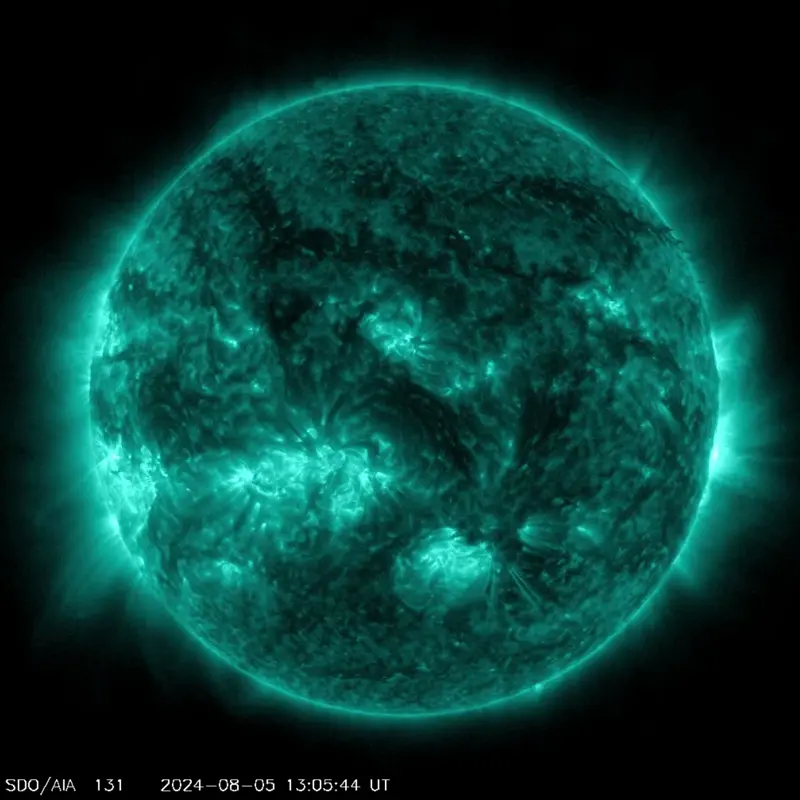
Sun news August 6: Bam! Bam! 2 X flares in 2 hours
? ? ? It’s an X flare duel between AR3767 and AR3780 on the west limb, then the east limb (edge). An X1.7, then an X1.1. Sun Fun! ? ? ? #spaceweather #solarmax pic.twitter.com/hBew7wIAWb
— Dr. C. Alex Young (@TheSunToday) August 5, 2024
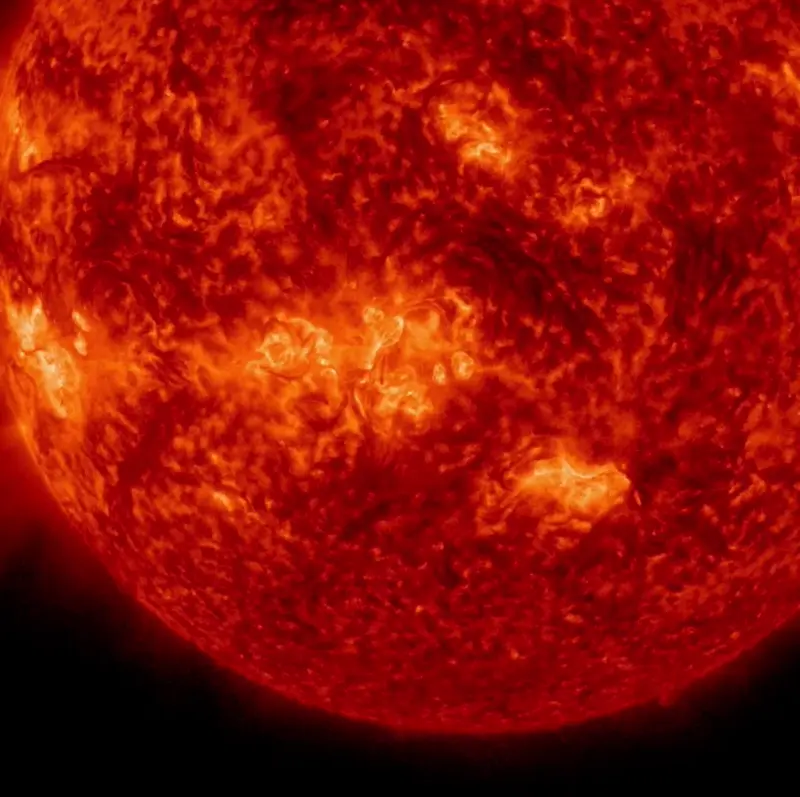
Sun news August 5: Two large active sunspot regions
They’re here! The two active sunspot groups we have been waiting on have rotated into view. The are numbered AR3780 in the southeast and AR3781 in the northeast. AR3781 erupted several times before any sunspots were in view. It produced an M5.5 flare from around the sun’s limb (edge). The flare was really much larger than M5.5, but it was partially occulted (blocked). The area has shown interesting activity with a large filament and plasma rotating around it. Now, AR3780 is the most active. It produced the most flares over the past 24 hours, including an M6.1. Both regions have not rotated enough into view to allow for an accurate determination of their magnetic complexity. Stay tuned to see what happens next.
Last 24 hours: Sun activity was high. We had five M flares – including an M6.1 – over the past day (between 11 UTC yesterday and 11 UTC today). The sun produced 16 flares in the past day: five M and 11 C. The largest flare was an M6.1 from active region AR3780 at 5:23 UTC on August 5. An R2 (moderate) radio blackout affected an area over South Asia. The list of M flares is:
• M2.2 at 15:15 UTC on August 3 from AR3774. R1 (minor) radio blackout over the Atlantic Ocean.
• M2.2 at 15:15 UTC on August 4 from AR3780. R1 (minor) radio blackout over the Atlantic Ocean.
• M1.0 at 22:11 UTC on August 4 from AR3780. R1 (minor) radio blackout over the Pacific Ocean.
• M1.2 at 02:31 UTC on August 5 from AR3780. R1 (minor) radio blackout over East Asia and the Pacific Ocean.
• M6.1 at 05:23 UTC on August 5 from AR3780. R2 (moderate) radio blackout over South Asia.
• M1.7 at 10:01 UTC on August 5 from AR3767. R1 (minor) radio blackout over the Middle East.
Active region AR3780 is the lead flare producer of the period, with nine flares (five M and four C). The sun has ten active regions on the Earth-facing side. The new regions for the period are AR3779, AR3780, and AR3781.
Sun news August 4: Large sunspot region rotating into view
Amazing! Another large sunspot region has begun to rotate into view. Another one (seen via helioseismology) in the northeast is not quite visible yet. But it has already released a moderate (M5.5) flare from over the sun’s limb (edge). Because it is not yet in view, this flare was more than likely much larger. Sun activity was mostly high over the past week. And these spots could mean a continuation of high activity. The M5.5 flare came about one hour after an M7.3 from region AR3775. This type of flaring was once thought to be just a coincidence. We now know that a flare from one location can trigger a flare at another location. This is called sympathetic flaring. This set of flares, the M5.5 and the M7.3, could be an example of sympathetic flaring. Stay tuned for more solar action.
Last 24 hours: Sun activity was high for several days last week, then dropped into a short lull, and now has increased back to high. We had eight M flares – including two flares over M5 – over the past day (between 11 UTC yesterday and 11 UTC today). Overall, the sun produced 17 flares in the past day: nine M and eight C flares. The largest flare was an M7.3 flare from active region AR3765 at 18:39 UTC on August 4. An R2 (moderate) radio blackout affected an area over the Arabian Sea. The list of M flares is:
• M1.8 at 13:43 UTC on August 3 from AR3774. R1 (minor) radio blackout off the Atlantic Ocean.
• M2.8 at 16:54 UTC on August 3 from AR3770. R1 (minor) radio blackout over the Americas.
• M1.9 at 17:26 UTC on August 3 from AR3766. R1 (minor) radio blackout over the Americas.
• M7.3 at 18:39 UTC on August 3 from AR3775. R2 (moderate) radio blackout over the Americas and Pacific.
• M5.5 at 19:30 UTC on August 3 from unnumbered northeast. R2 (moderate) radio blackout over the Americas and Pacific.
• M1.5 at 01:59 UTC on August 4 from unnumbered northeast. R1 (minor) radio blackout over the Pacific Ocean.
• M1.2 at 09:44 UTC on August 4 from unnumbered northeast. R1 (minor) radio blackout over the Middle East.
• M1.2 at 10:01 UTC on August 4 from AR3766. R1 (minor) radio blackout over the Middle East.
• M1.4 at 10:08 UTC on August 4 from AR3766. R1 (minor) radio blackout over the Middle East.
Active region AR3766 is the lead flare producer of the period, with seven flares (three M and four Cs). The sun has nine active regions on the Earth-facing side.
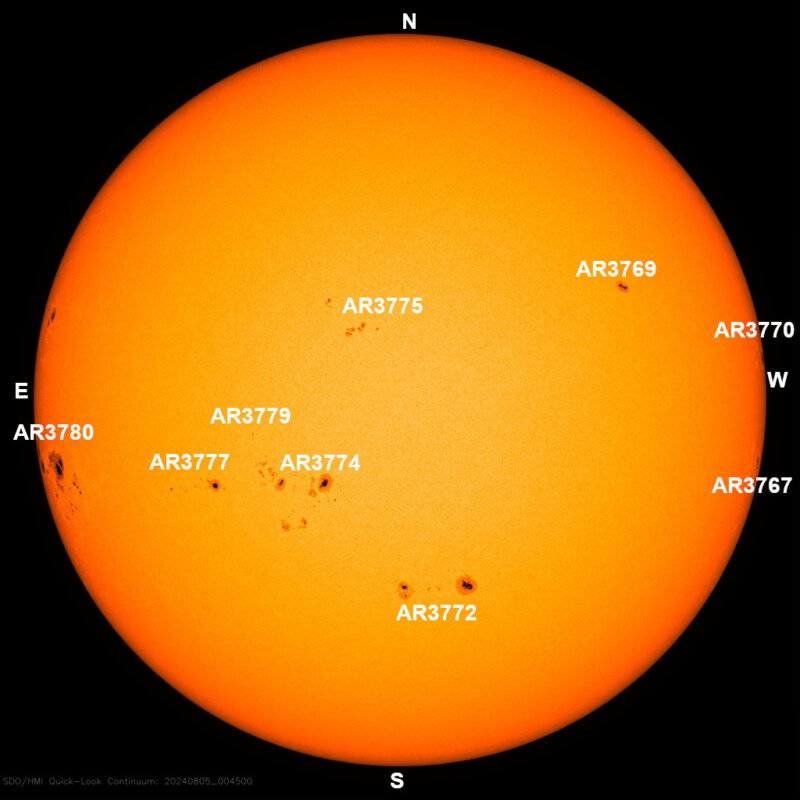
Sun news August 3: July 2024 was the peak of Solar Cycle 25 so far
It is now official! The monthly average sunspot number for July 2024 was 196.5, a new high. The previous maximum for this cycle was in May 2024 with 171.7. The last time the monthly average was higher than 196.5 was 23 years ago, back in December 2001. That month saw 213 sunspots, during Solar Cycle 23. And Solar Cycle 23’s peak was 244 sunspots in July 2000 (the month of the Bastille Day Flare). The original predictions for Solar Cycle 25 (made in 2019) estimated the cycle would be approximately the same size as the previous cycle, Solar Cycle 24. However, Solar Cycle 25 has surpassed this prediction. And this past week the sun has been quite active, leading to the chance for minor-to-moderate storming and auroras tonight (according to clocks in the Americas) into tomorrow morning. Clear skies and good luck! Stay tuned for more sun news.
Last 24 hours: During the past day, solar activity dropped down to moderate with only small M flares. Between 11 UTC yesterday and 11 UTC today, our observation period, the overall flare number increased from 18 to 23, with eight M and 15 C flares. The largest flare was an M1.9 flare from active region AR3765 at 7:30 UTC on August 3. An R1 (minor) radio blackout affected an area over the Arabian Sea. The list of M flares is:
• M1.2 at 12:33 UTC on August 2 from AR3773. R1 (minor) radio blackout off the African Northwest.
• M1.1 at 13:50 UTC on August 2 from AR3775. R1 (minor) radio blackout over the Atlantic Ocean.
• M1.5 at 15:30 UTC on August 2 from AR3766. R1 (minor) radio blackout over the middle of the Atlantic Ocean.
• M1.3 at 23:58 UTC on August 2 by unnumbered NE. R1 (minor) radio blackout over west Ocean Pacific.
• M1.0 at 00:27 UTC on August 3 by unnumbered SE. R1 (minor) radio blackout over west Ocean Pacific.
• M1.5 at 04:59 UTC on August 3 by AR3770. R1 (minor) radio blackout over Laos.
• M1.5 at 07:05 UTC on August 3 from AR3768. R1 (minor) radio blackout over India.
• M1.9 at 07:30 UTC on August 3 from AR3765. R1 (minor) radio blackout over the Arabian Sea off the northwest coast of India.
Active region AR3768 is the lead flare producer of the period, with seven flares (an M and three Cs). The sun has 12 active regions on the Earth-facing side. There is a newcomer: AR3777.
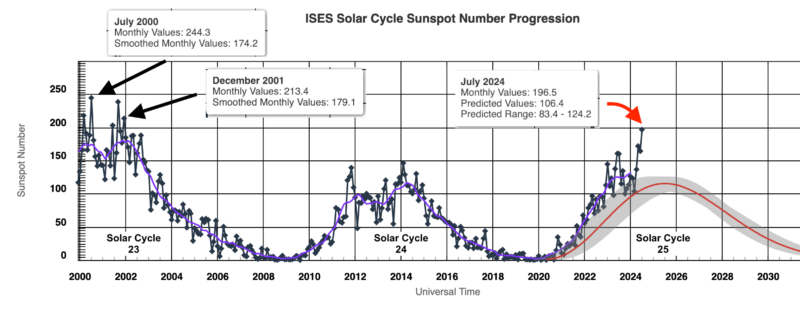
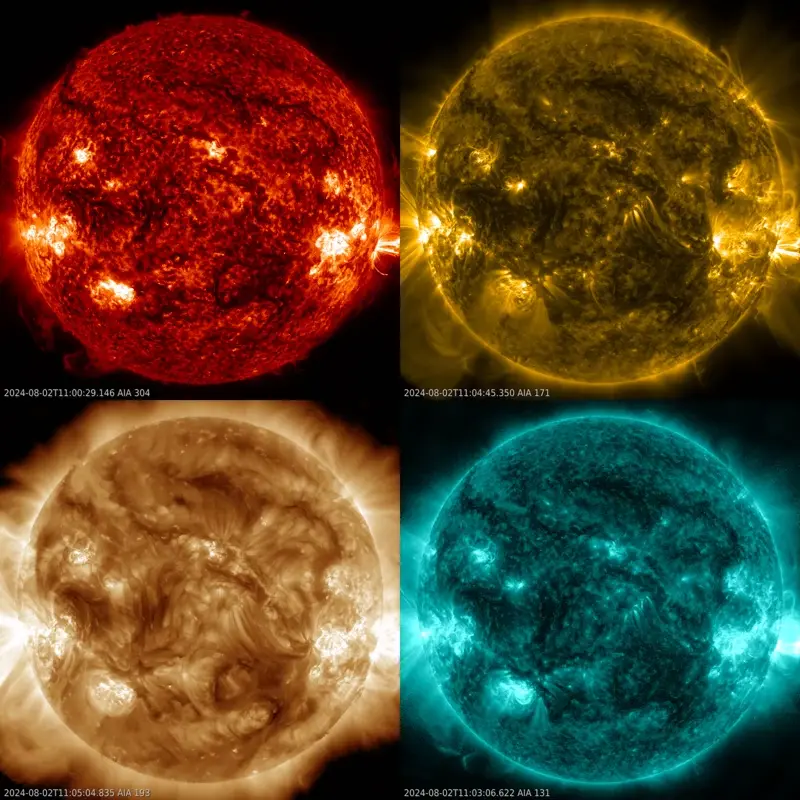


Sun news August 2: The M flares, and auroras, keep coming
What a week! Sun activity is still high. We just had another 24 hours with a fantastic number of M flares – 15 M flares in the past day including an M7.4 (almost an X flare). The sun is now peppered with sunspot regions on its Earth-facing side. In addition to all the sun action, more sun stuff that left our star during yesterday’s large flare is headed Earth’s way, adding to the chance for geomagnetic storming and auroras. Tonight (according to clocks in the Americas) into tomorrow morning, minor-to-moderate storming and auroras are expected. Clear skies and good luck! Stay tuned for more sun news.
Last 24 hours: The 15 M flares of the past day has kept sun activity high. Most of them were small M flares, but one of them, the largest, was an M7.4. Between 11 UTC and 11 UTC today, the sun produced a total of 18 flares: 15 M and four C flares. The largest flare, the M7.4, was a long-duration event that peaked at 4:55 UTC on August 2 from AR3768. It produced an extended R2 (moderate) radio blackout that affected an area starting in Taiwan in the Philippine Sea at around 4:23 UTC and extended through 6:13 UTC on August 2, affecting an area over Myanmar. The list of M flares is:
• M4.1 at 11:37 UTC on August 1 from AR3772. R1 (minor) radio blackout the African Northwest.
• M4.2 at 11:47 UTC on August 1 from AR3772. R1 (minor) radio blackout over the Northwest Africa.
• M1.1 at 16:15 UTC on August 1 from AR3764. R1 (minor) radio blackout over the Dominican Republic.
• M1.3 at 16:37 UTC on August 1 from AR3768. R1 (minor) radio blackout over Cuba.
• M1.6 at 16:47 UTC on August 1 from AR3774. R1 (minor) radio blackout over Cuba.
• M1.3 at 17:29 UTC on August 1 from AR3772. R1 (minor) radio blackout over Cuba.
• M1.2 at 20:22 UTC on August 1 from AR3774. R1 (minor) radio blackout over the Pacific Ocean.
• M1.4 at 23:08 UTC on August 1 from AR3774. R1 (minor) radio blackout over the Pacific Ocean.
• M1.0 at 02:01 UTC on August 2 from AR3765. R1 (minor) radio blackout over the Philippine Sea.
• M1.1 at 03:25 UTC on August 2 from AR3772. R1 (minor) radio blackout over the Philippine Sea.
• M1.2 at 03:58 UTC on August 2 from AR3768. R1 (minor) radio blackout over the Philippines.
• M7.4 at 04:55 UTC on August 2 from AR3768. R2 (moderate) radio blackout over China. Largest event
• M2.2 at 07:59 UTC on August 2 from AR3765. R1 (minor) radio blackout over Oman.
• M1.2 at 09:16 UTC on August 2 from AR3772. R1 (minor) radio blackout over the Middle East.
• M1.6 at 09:51 UTC on August 2 from AR3766. R1 (minor) radio blackout over the Middle East.
Active region AR3774 remains the lead flare producer. This time with five flares (three Ms and two Cs). Today, five active regions on the Earth-facing solar disk show a delta magnetic region, three of them, AR3765, AR3768 and AR3772 have a beta-gamma-delta magnetic complexity. In contrast, AR3767 and AR3770 have a beta-delta configuration. AR3766, AR3774, and AR3775 show a beta-gamma configuration, and the rest of the sunspot regions show alpha or beta. The sun has 12 active regions on the Earth-facing side. There is a newcomer: AR3776.
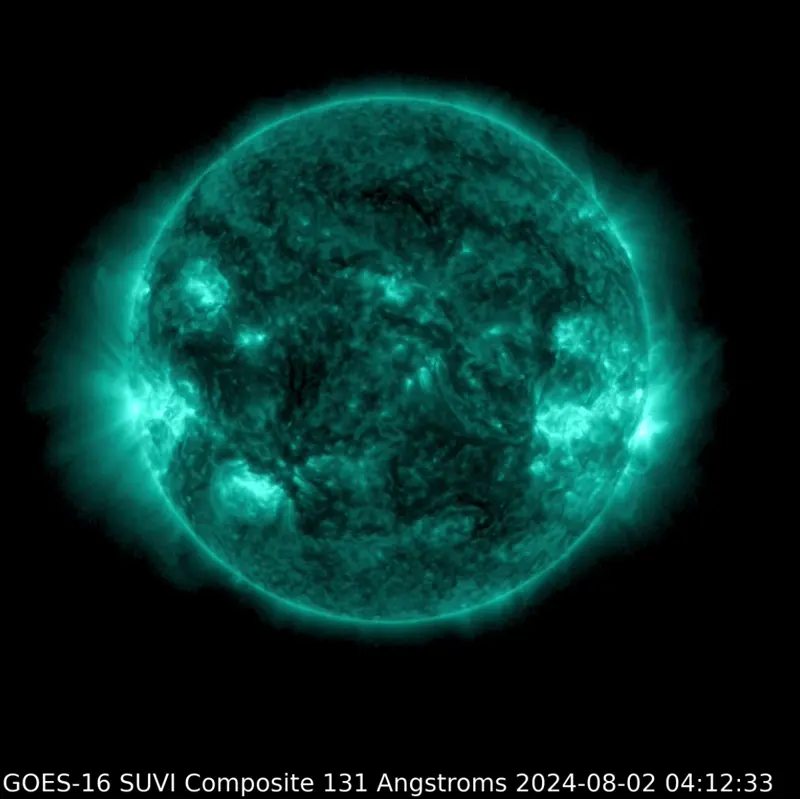
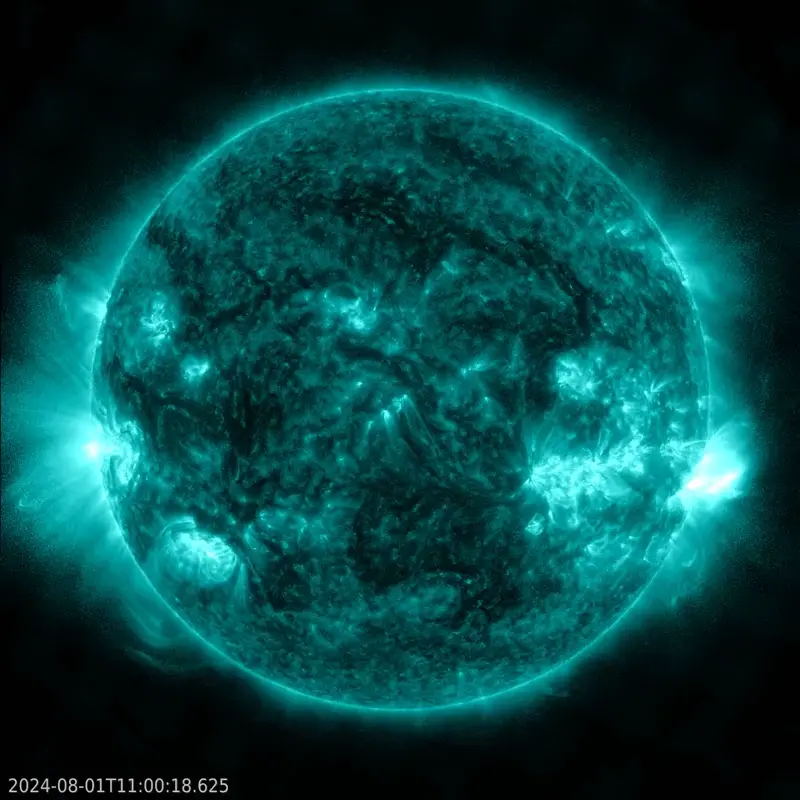
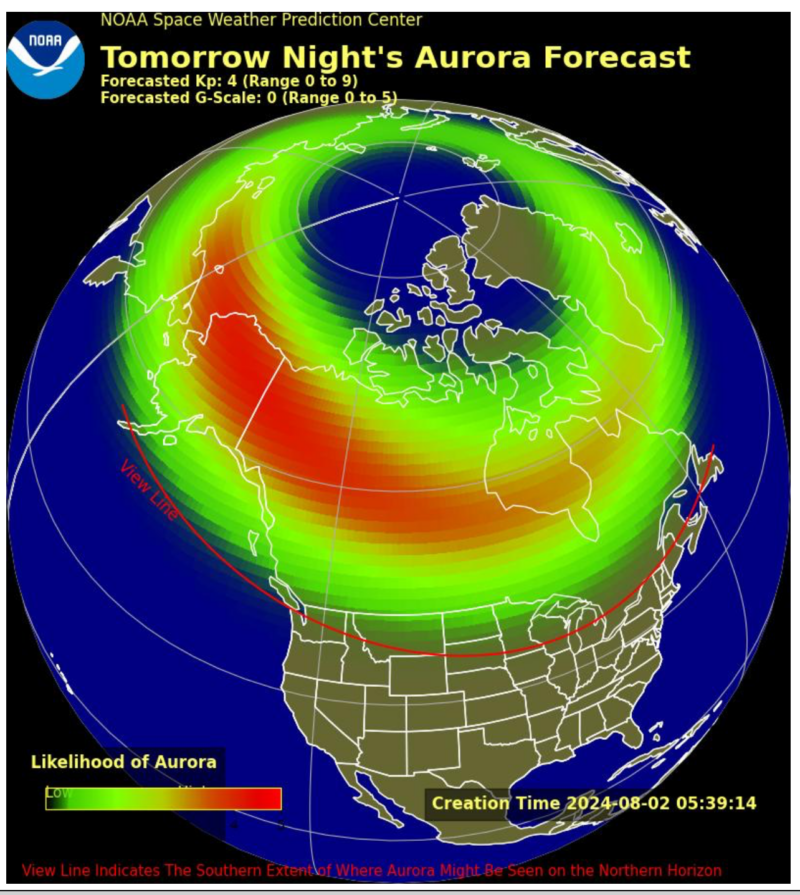
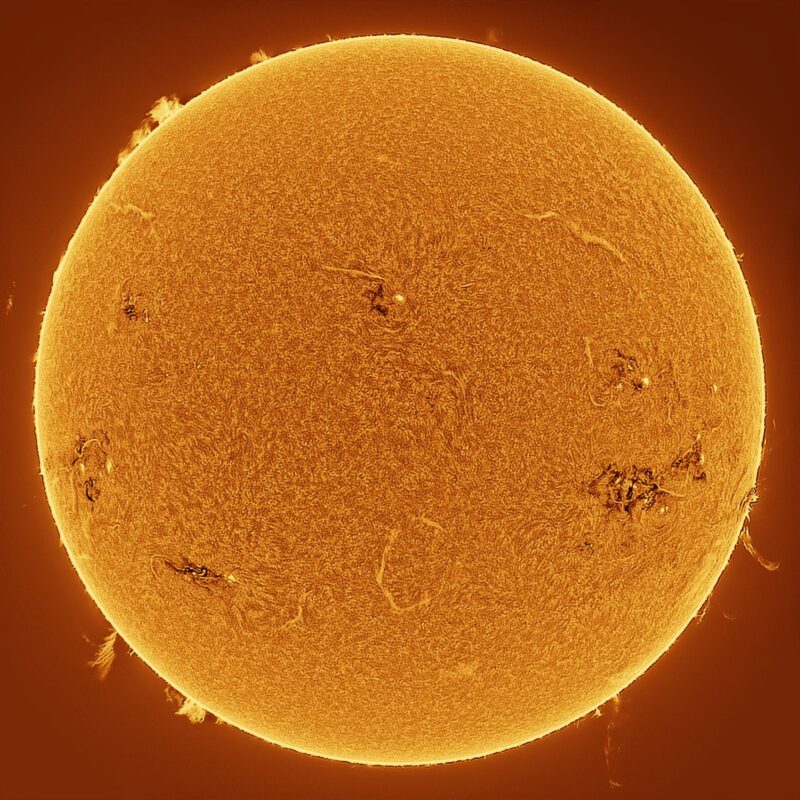
Sun news August 1: Activity is still high! Tons of M flares
This week’s high sun activity continues, with an impressive 15 M flares from several sunspot regions blasted over the past 24 hours. And it looks like the action will keep on coming. We can currently see a handful of sunspot groups with delta regions, which means they have the potential for major flaring. Plus the old region AR3738 (now AR3774) is back on the Earth-facing sun, having fired an incredible X14 flare while on the sun’s reverse, and is starting to come into full view. And to add to the excitement, more geomagnetic storming is forecast for tonight, so auroras could be on the way for those at higher latitudes! Stay tuned.
Last 24 hours: Sun activity is high after 15 M flares were fired over the past day, three of them above M5. Between 11 UTC and 11 UTC today, the sun produced 23 flares: 15 Ms and 8 C flares. The largest flare was an M8.1 at 7:08 UTC on August 1 from AR3768. The list of M flares is:
• M6.0 by 13:05 UTC on July 31 from AR3772. R2 (moderate) radio blackout over the Atlantic Ocean.
• M4.4 at 13:32 UTC on July 31 from AR3774. R1 (minor) radio blackout over the Atlantic Ocean off the coast of Africa.
• M1.4 at 16:31 UTC on July 31 from AR3774. R1 (minor) radio blackout over the Dominican Republic.
• M5.4 at 18:37 UTC on July 31 from AR3756. R2 (moderate) radio blackout over Mexico.
• M1.3 at 21:55 UTC on July 31 from ARAR3767. R1 (minor) radio blackout over Hawaii.
• M1.0 at 22:50 UTC on July 31 AR3774. R1 (minor) radio blackout over the Pacific Ocean off the coast of Hawaii.
• M1.2 at 0:58 UTC on August 1 from AR3770. R1 (minor) radio blackout over the Pacific Ocean.
• M6.3 at 1:50 UTC on August 1. from AR3773. R2 (moderate) radio blackout over the Philippine Sea.
• M1.0 at 2:25 UTC on August 1 from AR3762. R1 (minor) radio blackout over the Philippine Sea.
• M1.2 at 3:06 UTC ON August 1 from AR3774. R1 (minor) radio blackout over the Philippine Sea.
• M2.0 at 4:16 UTC on August 1 from AR3774. R1 (minor) radio blackout over Taiwan.
• M4.0 at 4:41 UTC on August 1 from AR3765. R1 (minor) radio blackout over Hong Kong.
• M1.5 at 5:56 UTC on August 1 from AR3765. R1 (minor) radio blackout over Myanmar.
• M1.3 at 6:06 UTC on August 1 from AR3768. R1 (minor) radio blackout over Bangladesh.
• M8.1 at 7:08 UTC on August 1 from AR3768. R2 (moderate) radio blackout over Africa. The largest.
Active region AR3774 was the lead flare producer with nine flares (four Ms and five Cs). Today, four active regions on the Earth-facing solar disk have a delta magnetic region. AR3765 and AR3768 have a beta-gamma-delta magnetic complexity while AR3767 and AR3770 have a beta-delta configuration. AR3762, AR3766 and AR3774 show a beta-gamma configuration, and the rest of the sunspot regions are showing alpha or beta. The sun has 12 active regions on the Earth-facing side. There is a newcomer: AR3775.












